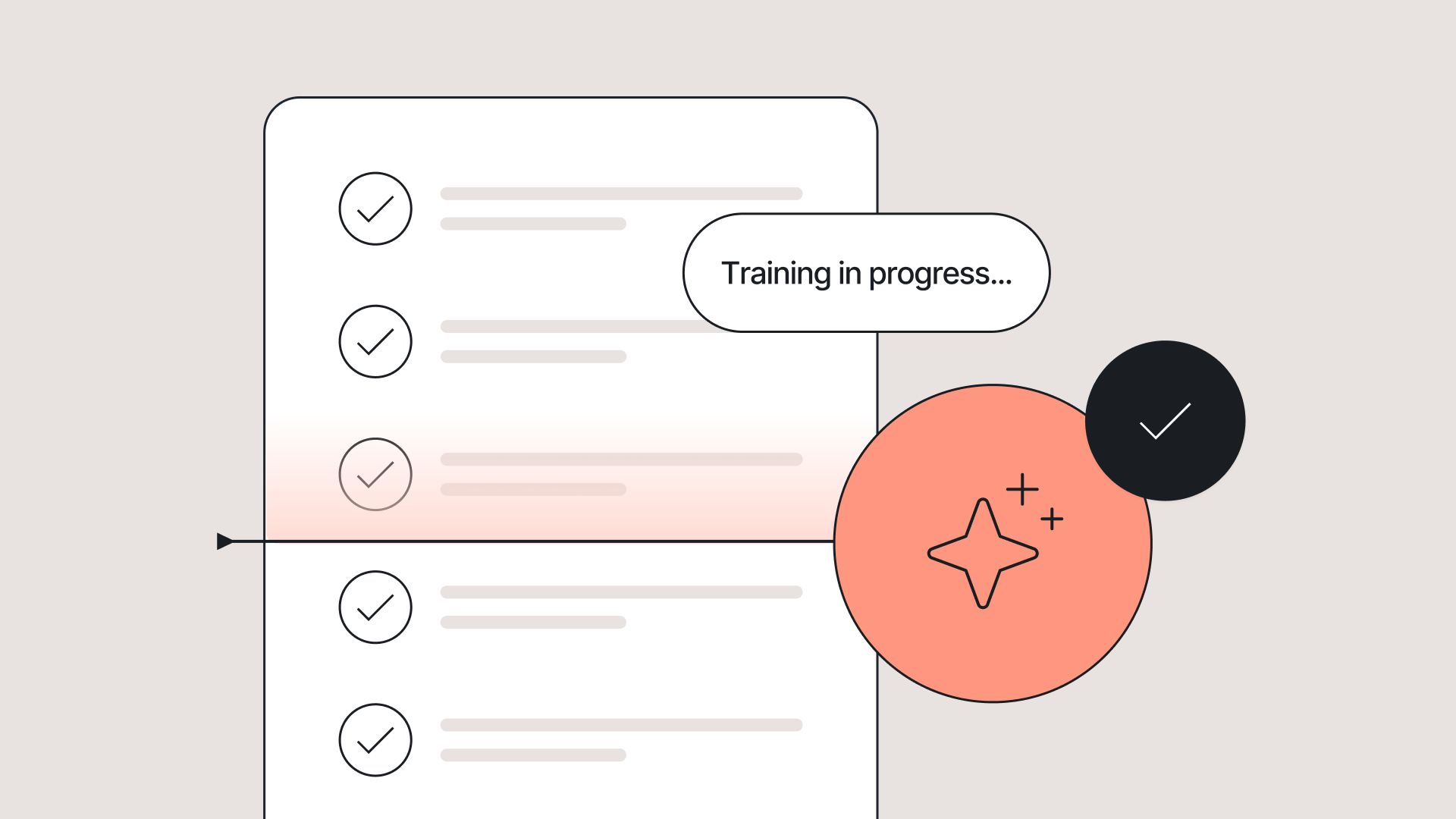
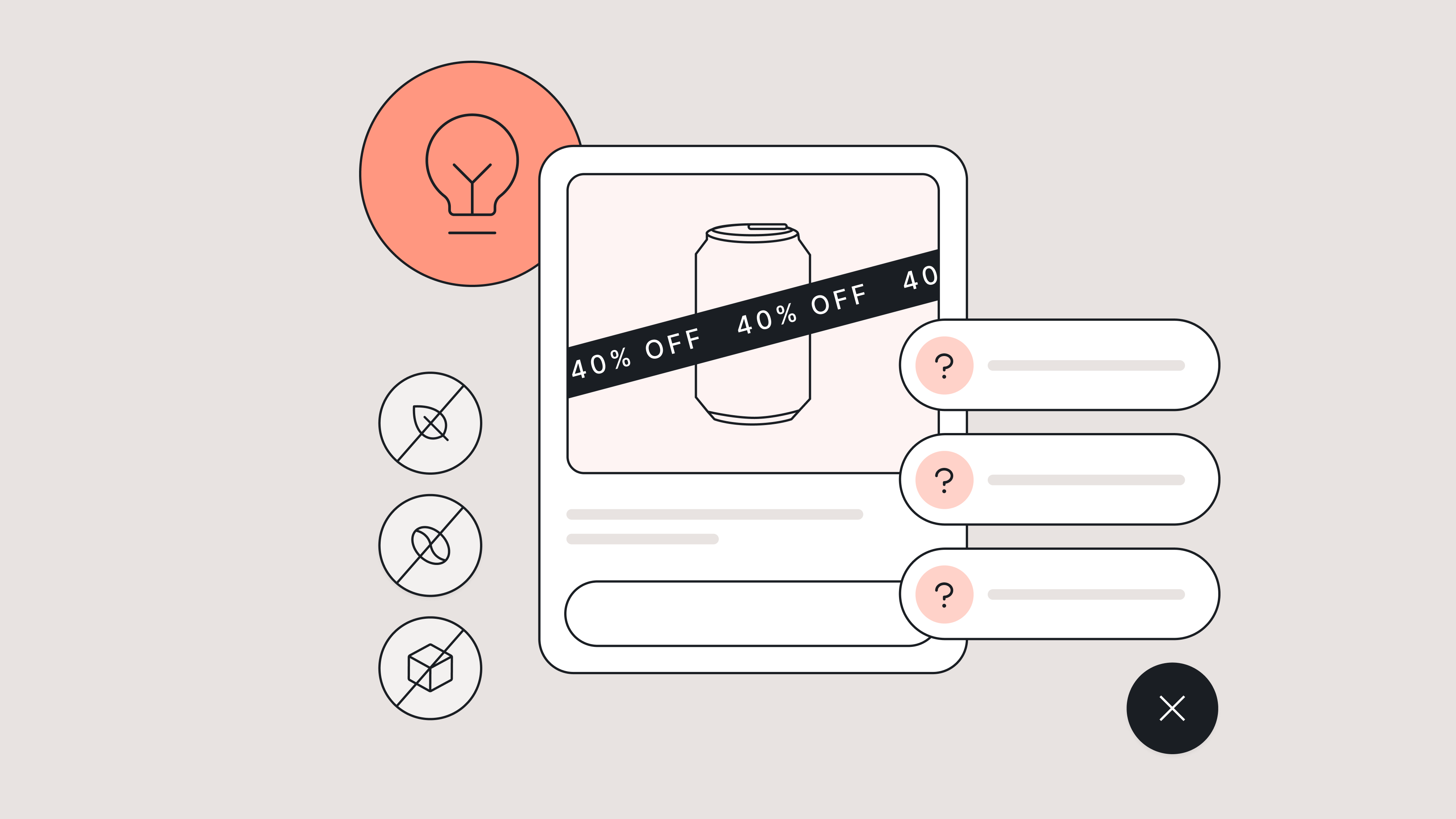

How Food & Beverage Brands Can Level Up Self-Service Before BFCM
TL;DR:
- Most food & beverage support tickets during BFCM are predictable. Subscription cancellations, WISMO, and product questions make up the bulk—so prep answers ahead of time.
- Proactive CX site updates can drastically cut down repetitive tickets. Add ingredient lists, cooking instructions, and clear refund policies to product pages and FAQs.
- FAQ pages should go deep, not just broad. Answer hyper-specific questions like “Will this break my fast?” to help customers self-serve without hesitation.
- Transparency about stock reduces confusion and cart abandonment. Show inventory levels, set up waitlists, and clearly state cancellation windows.
In 2024, Shopify merchants drove $11.5 billion in sales over Black Friday Cyber Monday. Now, BFCM is quickly approaching, with some brands and major retailers already hosting sales.
If you’re feeling late to prepare for the season or want to maximize the number of sales you’ll make, we’ll cover how food and beverage CX teams can serve up better self-serve resources for this year’s BFCM.
Learn how to answer and deflect customers’ top questions before they’re escalated to your support team.
💡 Your guide to everything peak season → The Gorgias BFCM Hub
Handling BFCM as a food & beverage brand
During busy seasons like BFCM and beyond, staying on top of routine customer asks can be an extreme challenge.
“Every founder thinks BFCM is the highest peak feeling of nervousness,” says Ron Shah, CEO and Co-founder of supplement brand Obvi.
“It’s a tough week. So anything that makes our team’s life easier instantly means we can focus more on things that need the time,” he continues.
Anticipating contact reasons and preparing methods (like automated responses, macros, and enabling an AI Agent) is something that can help. Below, find the top contact reasons for food and beverage companies in 2025.
Top contact reasons in the food & beverage industry
According to Gorgias proprietary data, the top reason customers reach out to brands in the food and beverage industry is to cancel a subscription (13%) followed by order status questions (9.1%).
Contact Reason |
% of Tickets |
|---|---|
🍽️ Subscription cancellation |
13% |
🚚 Order status (WISMO) |
9.1% |
❌ Order cancellation |
6.5% |
🥫 Product details |
5.7% |
🧃 Product availability |
4.1% |
⭐ Positive feedback |
3.9% |
7 ways to improve your self-serve resources before BFCM
- Add informative blurbs on product pages
- Craft additional help center and FAQ articles
- Automate responses with AI or Macros
- Get specific about product availability
- Provide order cancellation and refund policies upfront
- Add how-to information
- Build resources to help with buying decisions
1) Add informative blurbs on product pages
Because product detail queries represent 5.7% of contact reasons for the food and beverage industry, the more information you provide on your product pages, the better.
Include things like calorie content, nutritional information, and all ingredients.
For example, ready-to-heat meal company The Dinner Ladies includes a dropdown menu on each product page for further reading. Categories include serving instructions, a full ingredient list, allergens, nutritional information, and even a handy “size guide” that shows how many people the meal serves.
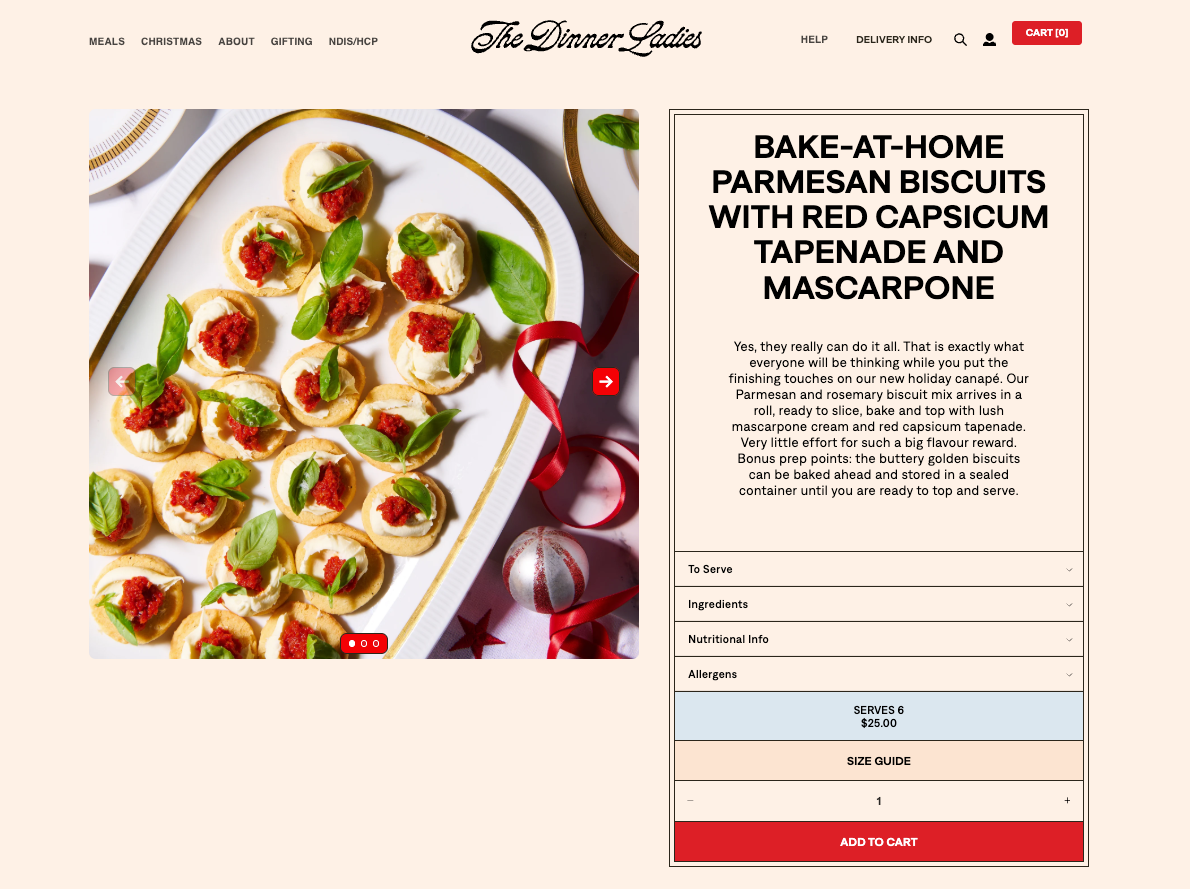
2) Craft additional Help Center and FAQ articles
FAQ pages make up the information hub of your website. They exist to provide customers with a way to get their questions answered without reaching out to you.
This includes information like how food should be stored, how long its shelf life is, delivery range, and serving instructions. FAQs can even direct customers toward finding out where their order is and what its status is.

In the context of BFCM, FAQs are all about deflecting repetitive questions away from your team and assisting shoppers in finding what they need faster.
That’s the strategy for German supplement brand mybacs.
“Our focus is to improve automations to make it easier for customers to self-handle their requests. This goes hand in hand with making our FAQs more comprehensive to give customers all the information they need,” says Alexander Grassmann, its Co-Founder & COO.
As you contemplate what to add to your FAQ page, remember that more information is usually better. That’s the approach Everyday Dose takes, answering even hyper-specific questions like, “Will it break my fast?” or “Do I have to use milk?”
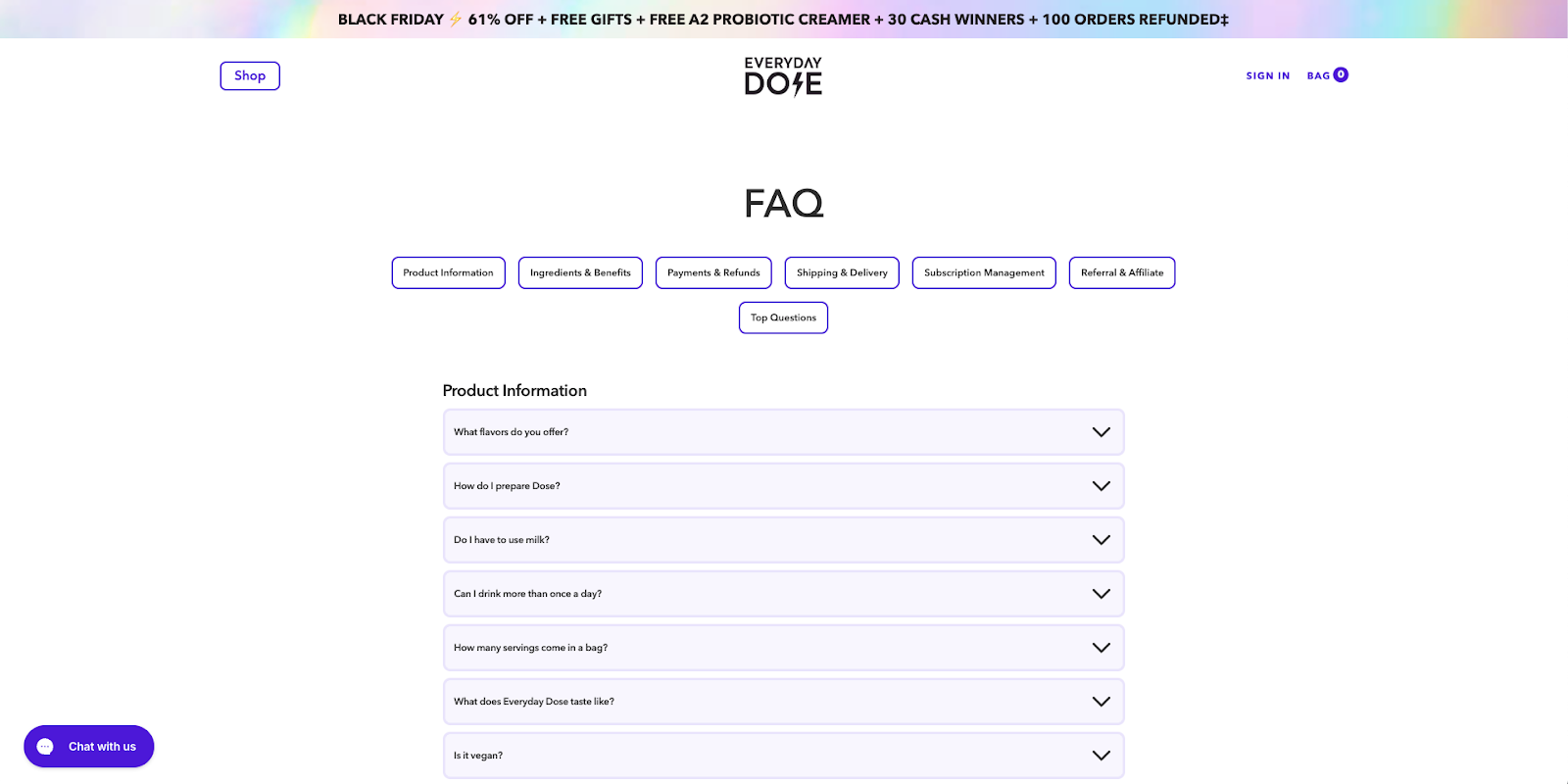
While the FAQs you choose to add will be specific to your products, peruse the top-notch food and bev FAQ pages below.
Time for some FAQ inspo:
- Juice Plus+ FAQ
- Everyday Dose FAQ
- Chamberlain Coffee FAQ
- Jurassic Fruit FAQ
- Rebel Cheese FAQ
- The Dinner Ladies FAQ
3) Automate responses with AI or macros
AI Agents and AI-powered Shopping Assistants are easy to set up and are extremely effective in handling customer interactions––especially during BFCM.
“I told our team we were going to onboard Gorgias AI Agent for BFCM, so a good portion of tickets would be handled automatically,” says Ron Shah, CEO and Co-founder at Obvi. “There was a huge sigh of relief knowing that customers were going to be taken care of.”
And, they’re getting smarter. AI Agent’s CSAT is just 0.6 points shy of human agents’ average CSAT score.
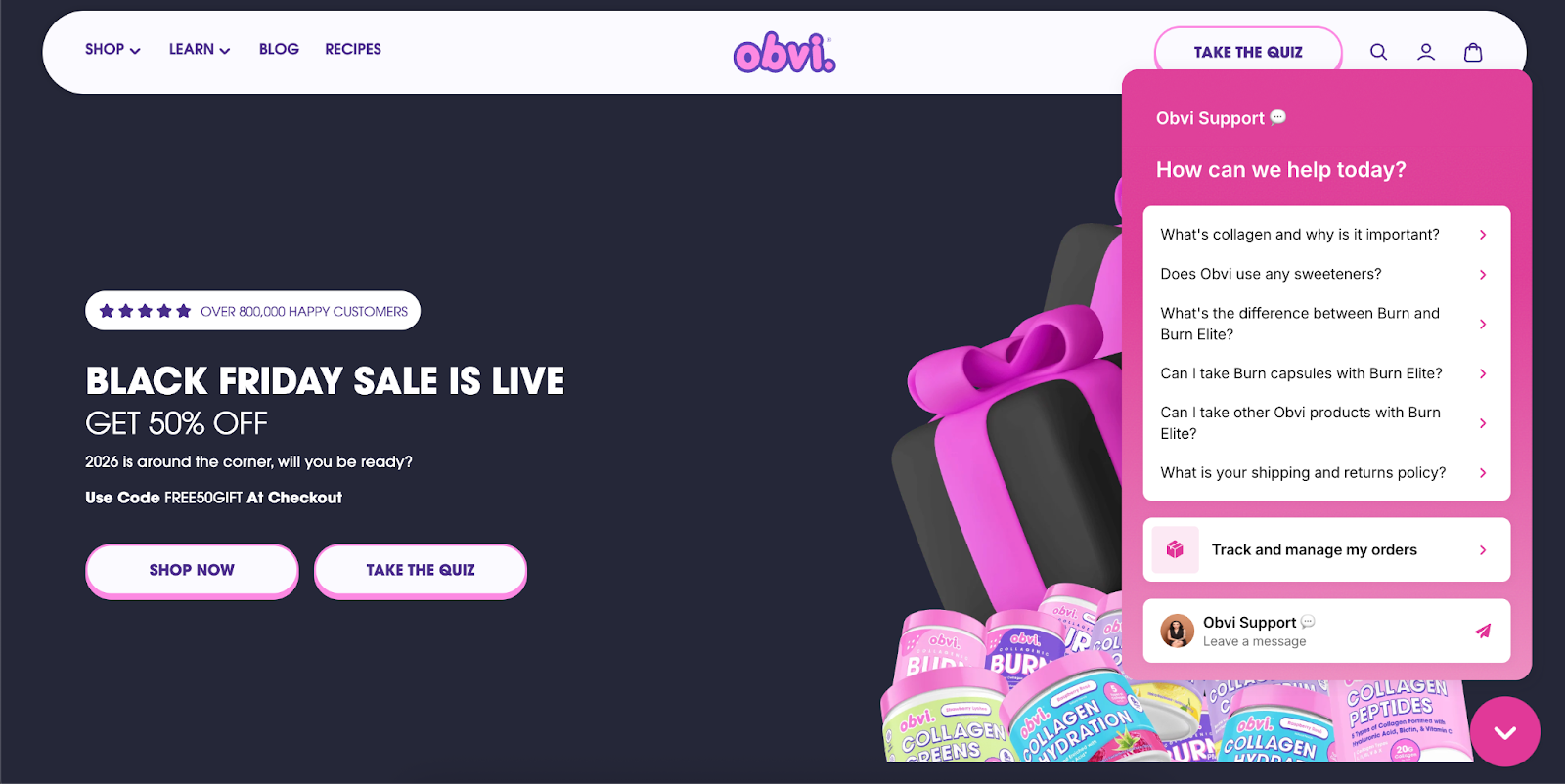
Here are the specific responses and use cases we recommend automating:
- WISMO (where is my order) inquiries
- Product related questions
- Returns
- Order issues
- Cancellations
- Discounts, including BFCM related
- Customer feedback
- Account management
- Collaboration requests
- Rerouting complex queries
Get your checklist here: How to prep for peak season: BFCM automation checklist
4) Get specific about product availability
With high price reductions often comes faster-than-usual sell out times. By offering transparency around item quantities, you can avoid frustrated or upset customers.
For example, you could show how many items are left under a certain threshold (e.g. “Only 10 items left”), or, like Rebel Cheese does, mention whether items have sold out in the past.

You could also set up presales, give people the option to add themselves to a waitlist, and provide early access to VIP shoppers.
5) Provide order cancellation and refund policies upfront
Give shoppers a heads up whether they’ll be able to cancel an order once placed, and what your refund policies are.
For example, cookware brand Misen follows its order confirmation email with a “change or cancel within one hour” email that provides a handy link to do so.
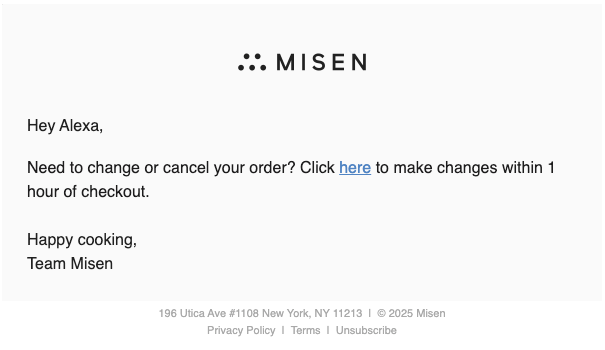
Your refund policies and order cancellations should live within an FAQ and in the footer of your website.
6) Add how-to information
Include how-to information on your website within your FAQs, on your blog, or as a standalone webpage. That might be sharing how to use a product, how to cook with it, or how to prepare it. This can prevent customers from asking questions like, “how do you use this?” or “how do I cook this?” or “what can I use this with?” etc.
For example, Purity Coffee created a full brewing guide with illustrations:
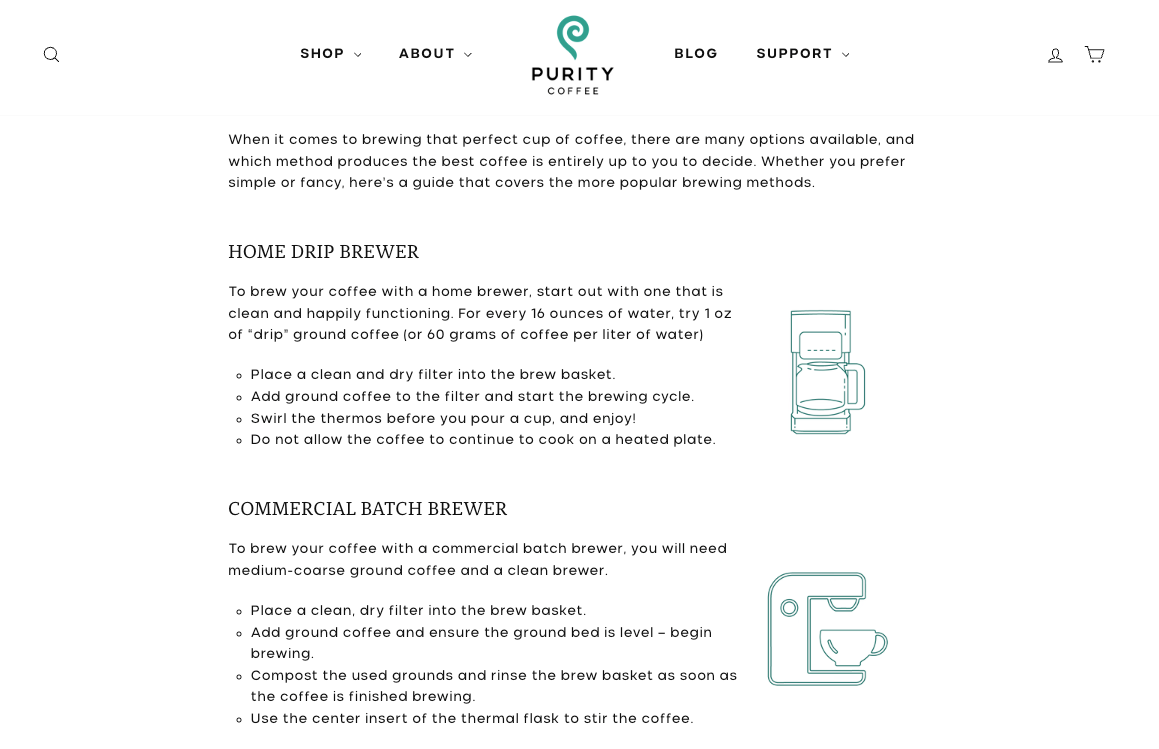
Similarly, for its unique preseasoned carbon steel pan, Misen lists out care instructions:

And for those who want to understand the level of prep and cooking time involved, The Dinner Ladies feature cooking instructions on each product page.
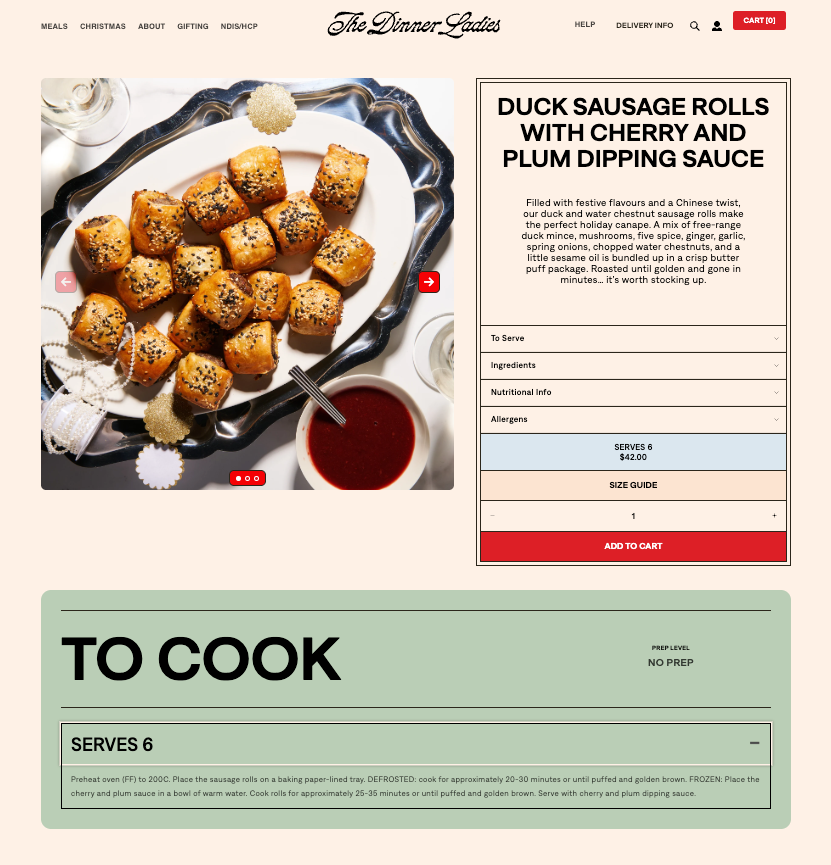
7) Build resources to help with buying decisions
Interactive quizzes, buying guides, and gift guides can help ensure shoppers choose the right items for them––without contacting you first.
For example, Trade Coffee Co created a quiz to help first timers find their perfect coffee match:
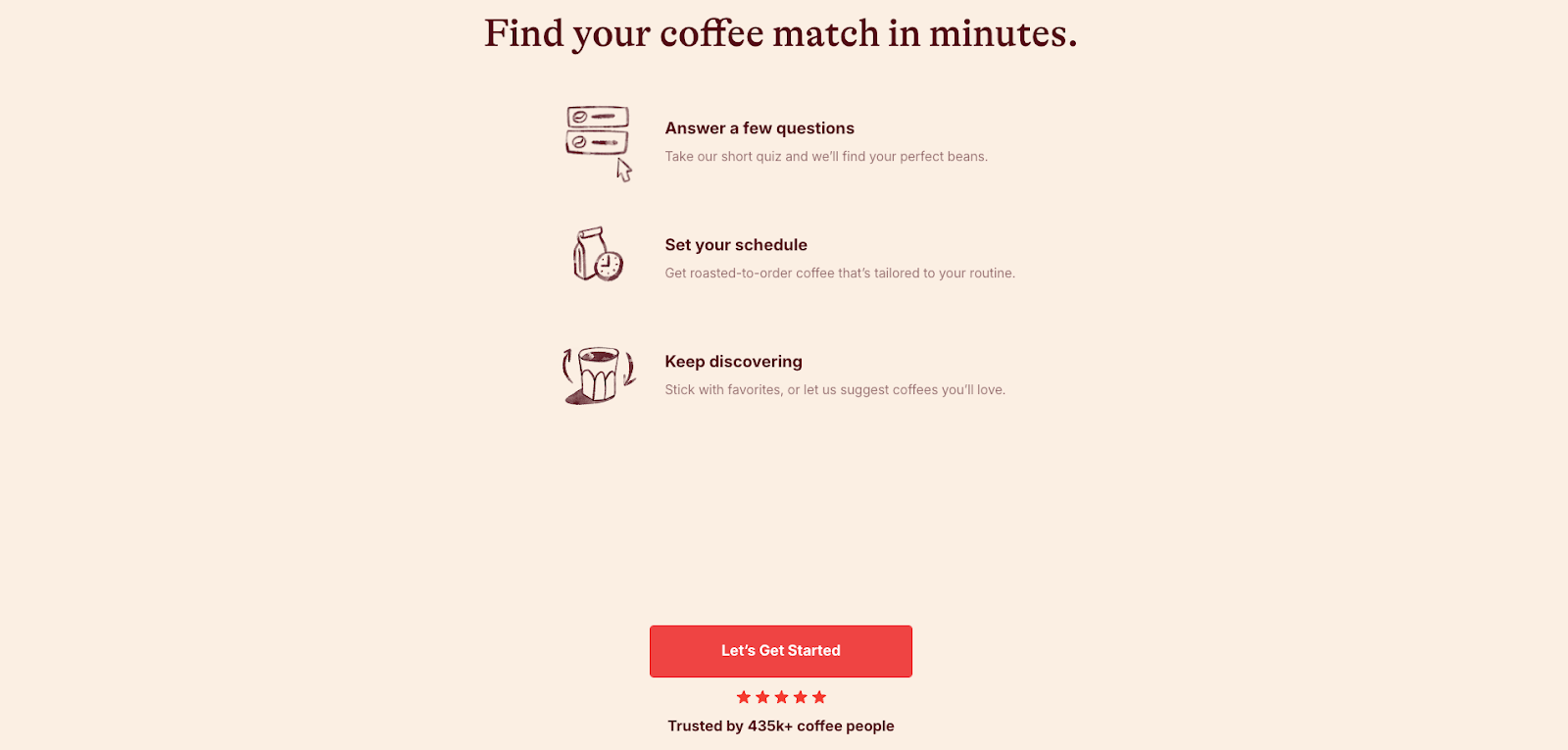
Set your team up for BFCM success with Gorgias
The more information you can share with customers upfront, the better. That will leave your team time to tackle the heady stuff.
If you’re looking for an AI-assist this season, check out Gorgias’s suite of products like AI Agent and Shopping Assistant.
{{lead-magnet-2}}
When Rhoback introduced an AI Agent to its customer experience team, it did more than automate routine tickets. Implementation revealed an opportunity to improve documentation, collaborate cross-functionally, and establish a clear brand tone of voice.
Samantha Gagliardi, Associate Director of Customer Experience at Rhoback, explains the entire process in the first episode of our AI in CX webinar series.
Key takeaways:
- Implement quickly and iterate. Rhoback’s initial rollout process took two weeks, right before BFCM. Samantha moved quickly, starting with basic FAQs and then continuously optimizing.
- Train AI like a three-year-old. Although it is empathetic, an AI Agent does not inherently know what is right or wrong. Invest in writing clear Guidance, testing responses, and ensuring document accuracy.
- Approach your AI’s tone of voice like a character study. Your AI Agent is an extension of your brand, and its personality should reflect that. Rhoback conducted a complete analysis of its agent’s tone, age, energy, and vocabulary.
- Embrace AI as a tool to reveal inconsistencies. If your AI Agent is giving inaccurate information, it’s exposing gaps in your knowledge sources. Uses these early test responses to audit product pages, help center content, Guidance, and policies.
- Check in regularly and keep humans in control. Introduce weekly reviews or QA rituals to refine AI’s accuracy, tone, and efficiency. Communicate AI insights cross-functionally to build trust and work towards shared goals.
Top learnings from Rhoback’s AI rollout
1. You can start before you “feel ready”
With any new tool, the pre-implementation phase can take some time. Creating proper documentation, training internal teams, and integrating with your tech stack are all important steps that happen before you go live.
But sometimes it’s okay just to launch a tool and optimize as you go.
Rhoback launched its AI agent two weeks before BFCM to automate routine tickets during the busy season.
Why it worked:
- Samantha had audited all of Rhoback’s SOPs, training materials, and FAQs a few months before implementation.
- They started by automating high-volume questions such as returns, exchanges, and order tracking.
- They followed a structured AI implementation checklist.
2. Audit your knowledge sources before you automate
Before turning on Rhoback’s AI Agent, Samantha’s team reviewed every FAQ, policy, and help article that human agents are trained on. This helped establish clear CX expectations that they could program into an AI Agent.
Samantha also reviewed the most frequently asked questions and the ideal responses to each. Which ones needed an empathetic human touch and which ones required fast, accurate information?
“AI tells you immediately when your data isn’t clean. If a product detail page says one thing and the help center says another, it shows up right away.”
Rhoback’s pre-implementation audit checklist:
- Review customer FAQs and the appropriate responses for each.
- Update outdated PDPs, Help Centre articles, policies, and other relevant documentation.
- Establish workflows with Ecommerce and Product teams to align Macros, Guidance, and Help Center articles with product descriptions and website copy.
Read more: How to Optimize Your Help Center for AI Agent
3. Train your AI Agent in small, clear steps
It’s often said that you should train your AI Agent like a brand-new employee.
Samantha took it one step further and recommended treating AI like a toddler, with clear, patient, repetitive instructions.
“The AI does not have a sense of good and bad. It’s going to say whatever you train it, so you need to break it down like you’re talking to a three-year-old that doesn’t know any different. Your directions should be so detailed that there is no room for error.”
Practical tips:
- Use AI to build your AI Guidance, focusing on clear, detailed, simple instructions.
- Test each Guidance before adding new ones.
- Treat the training process like an ongoing feedback loop, not a one-time upload.
Read more: How to Write Guidance with the “When, If, Then” Framework
4. Prioritize Tone of Voice to make AI feel natural
For Rhoback, an on-brand Tone of Voice was a non-negotiable. Samantha built a character study that shaped Rhoback’s AI Agent’s custom brand voice.
“I built out the character of Rhoback, how it talks, what age it feels like, what its personality is. If it does not sound like us, it is not worth implementing.”
Key questions to shape your AI Agent’s tone of voice:
- How does the AI Agent speak? Friendly, funny, empathetic, etc…?
- Does your AI Agent use emojis? How often?
- Are there any terms or phrases the AI Agent should always or never say?
5. Use AI to surface knowledge gaps or inconsistencies
Once Samantha started testing the AI Agent, it quickly revealed misalignment between Rhoback’s teams. With such an extensive product catalog, AI showed that product details did not always match the Help Center or CX documentation.
This made a case for stronger collaboration amongst the CX, Product, and Ecommerce teams to work towards their shared goal of prioritizing the customer.
“It opened up conversations we were not having before. We all want the customer to be happy, from the moment they click on an ad to the moment they purchase to the moment they receive their order. AI Agent allowed us to see the areas we need to improve upon.”
Tips to improve internal alignment:
- Create regular syncs between CX, Product, Ecommerce, and Marketing teams.
- Share AI summaries, QA insights, and trends to highlight recurring customer pain points.
- Build a collaborative workflow for updating documents that gives each team visibility.
6. Build trust (with your team and customers) through transparency
Despite the benefits of AI for CX, there’s still trepidation. Agents are concerned that AI would replace them, while customers worry they won’t be able to reach a human. Both are valid concerns, but clearly communicating internally and externally can mitigate skepticism.
At Rhoback, Samantha built internal trust by looping in key stakeholders throughout the testing process. “I showed my team that it is not replacing them. It’s meant to be a support that helps them be even more successful with what they’re already doing," Samantha explains.
On the customer side, Samantha trained their AI Agent to tell customers in the first message that it is an AI customer service assistant that will try to help them or pass them along to a human if it can’t.
How Rhoback built AI confidence:
- Positioned AI as a personal assistant for agents, not a replacement.
- Let agents, other departments, and leadership test and shape the AI Agent experience early.
- Told customers up front when automation was being used and made the path to a human clear and easy.
Read more: How CX Leaders are Actually Using AI: 6 Must-Know Lessons
Putting these into practice: Rhoback’s framework for an aligned AI implementation
Here is Rhoback’s approach distilled into a simple framework you can apply.
- Audit your content: Ensure your FAQs, product data, policies, and all documentation are accurate.
- Start small: Automate one repetitive workflow, such as returns or tracking.
- Train iteratively: Add Guidance in small, testable batches.
- Prioritize tone: Make sure every AI reply sounds like your brand.
- Align teams: Use AI data to resolve cross-departmental inconsistencies and establish clearer communication lines.
- Be transparent: Tell both agents and customers how AI fits into the process.
- Refine regularly: Review, measure, and adjust on an ongoing basis.
Watch the full conversation with Samantha to learn how AI can act as a catalyst for better internal alignment.
📌 Join us for episode 2 of AI in CX: Building a Conversational Commerce Strategy that Converts with Cornbread Hemp on December 16.
{{lead-magnet-1}}
TL;DR:
- You don’t need to rebuild your Help Center to make it work with AI—you just need to structure it smarter.
- AI Agent reads your content in three layers: Help Center, Guidance, and Actions, following an “if / when / then” logic to find and share accurate answers.
- Most AI escalations happen because Help Docs are vague or incomplete. Start by improving your top 10 ticket topics—like order status, returns, and refunds.
- Make your articles scannable, define clear conditions, link next steps, and keep your tone consistent. These small tweaks help AI Agent resolve more tickets on its own—and free up your team to focus on what matters most.
As holiday season support volumes spike and teams lean on AI to keep up, one frustration keeps surfacing, our Help Center has the answers—so why can’t AI find them?
The truth is, AI can’t help customers if it can’t understand your Help Center. Most large language models (LLMs), including Gorgias AI Agent, don’t ignore your existing docs, they just struggle to find clear, structured answers inside them.
The good news is you don’t need to rebuild your Help Center or overhaul your content. You simply need to format it in a way that’s easy for both people and AI to read.
We’ll break down how AI Agent reads your Help Center, finds answers, and why small formatting changes can help it respond faster and more accurately, so your team spends less time on escalations.
{{lead-magnet-1}}
How AI Agent uses your Help Center content
Before you start rewriting your Help Center, it helps to understand how AI Agent actually reads and uses it.
Think of it like a three-step process that mirrors how a trained support rep thinks through a ticket.
1. Read Help Center docs
Your Help Center is AI Agent’s brain. AI Agent uses your Help Center to pull facts, policies, and instructions it needs to respond to customers accurately. If your articles are clearly structured and easy to scan, AI Agent can find what it needs fast. If not, it hesitates or escalates.
2. Follow Guidance instructions
Think of Guidance as AI Agent’s decision layer. What should AI Agent do when someone asks for a refund? What about when they ask for a discount? Guidance helps AI Agent provide accurate answers or hand over to a human by following an “if/when/then” framework.
3. Respond and perform
Finally, AI Agent uses a combination of your help docs and Guidance to respond to customers, and if enabled, perform an Action on their behalf—whether that’s changing a shipping address or canceling an order altogether.
Here’s what that looks like in practice:
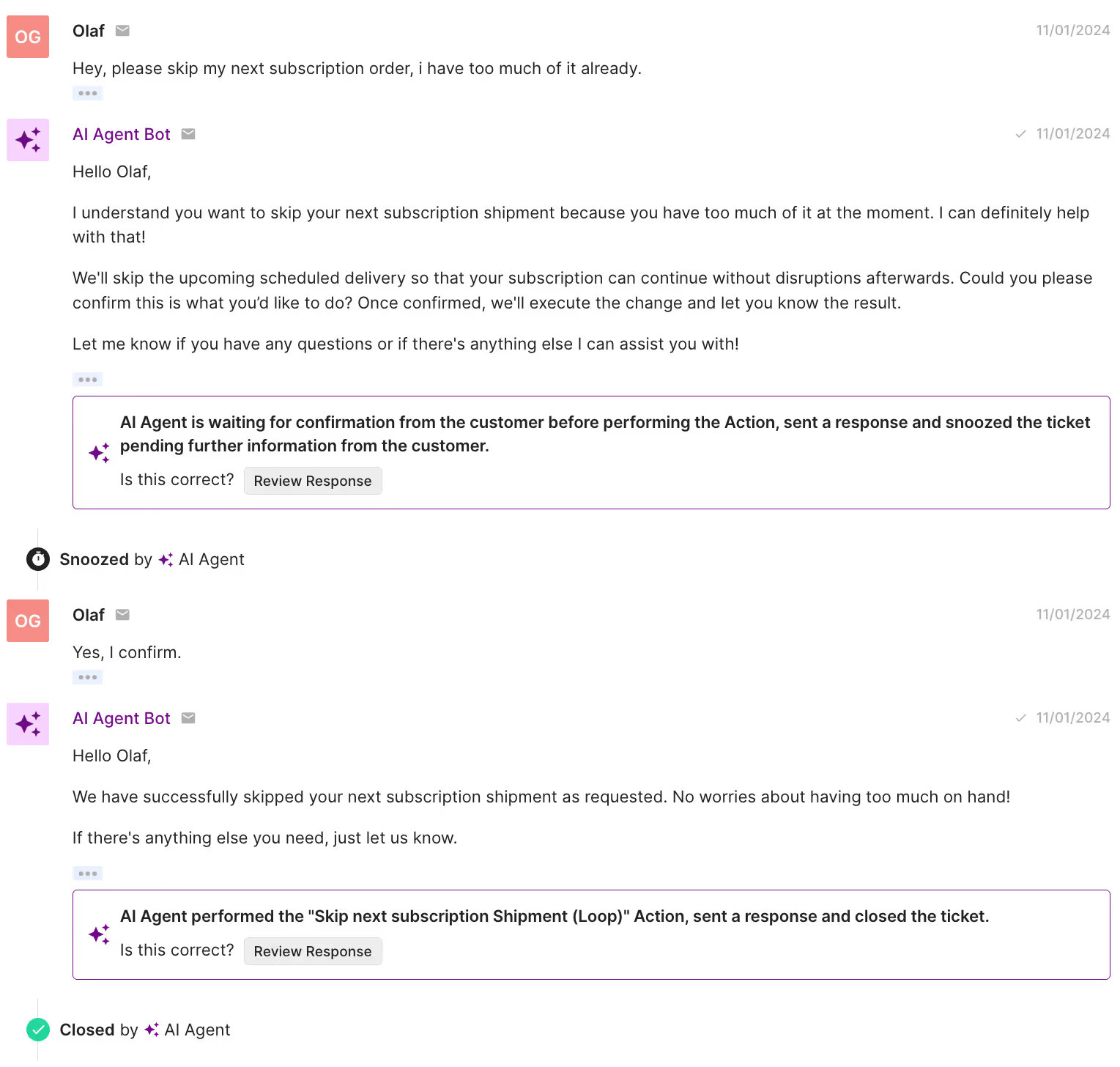
This structure removes guesswork for both your AI and your customers. The clearer your docs are about when something applies and what happens next, the more accurate and human your automated responses will feel.
A Help Center written for both people and AI Agent:
- Saves your team time
- Reduces escalations
- Helps every customer get the right answer the first time
What causes AI Agent to escalate tickets, and how to fix it
Our data shows that most AI escalations happen for a simple reason––your Help Center doesn’t clearly answer the question your customer is asking.
That’s not a failure of AI. It’s a content issue. When articles are vague, outdated, or missing key details, AI Agent can’t confidently respond, so it passes the ticket to a human.
Here are the top 10 topics that trigger escalations most often:
Rank |
Ticket Topic |
% of Escalations |
|---|---|---|
1 |
Order status |
12.4% |
2 |
Return request |
7.9% |
3 |
Order cancellation |
6.1% |
4 |
Product - quality issues |
5.9% |
5 |
Missing item |
4.6% |
6 |
Subscription cancellation |
4.4% |
7 |
Order refund |
4.1% |
8 |
Product details |
3.5% |
9 |
Return status |
3.3% |
10 |
Order delivered but not received |
3.1% |
Each of these topics needs a dedicated, clearly structured Help Doc that uses keywords customers are likely to search and spells out specific conditions.
Here’s how to strengthen each one:
- Order status: Include expected delivery timelines, tracking link FAQs, and a clear section for “what to do if tracking isn’t updating.”
- Return request: Spell out eligibility requirements, time limits, and how to print or request a return label.
- Order cancellation: Define cut-off times for canceling and link to your “returns” doc for shipped orders.
- Product quality issues: Explain what qualifies as a defect, how to submit photos, and whether replacements or refunds apply.
- Missing item: Clarify how to report missing items and what verification steps your team takes before reshipping.
- Subscription cancellation: Add “if/then” logic for different cases: if paused vs. canceled, if prepaid vs. monthly.
- Order refund: Outline refund timelines, where customers can see status updates, and any exceptions (e.g., partial refunds).
- Product details: Cover sizing, materials, compatibility, or FAQs that drive most product-related questions.
- Return status: State how long returns take to process and where to check progress once a label is scanned.
- Order delivered but not received: Provide step-by-step guidance for checking with neighbors, filing claims, or requesting replacements.
Start by improving these 10 articles first. Together, they account for nearly half of all AI Agent escalations. The clearer your Help Center is on these topics, the fewer tickets your team will ever see, and the faster your AI will resolve the rest.
How to format your Help Center docs for LLMs
Once you know how AI Agent reads your content, the next step is formatting your help docs so it can easily understand and use them.
The goal isn’t to rewrite everything, it’s to make your articles more structured, scannable, and logic-friendly.
Here’s how.
1. Use structured, scannable sections
Both humans and large language models read hierarchically. If your article runs together in one long block of text, key answers get buried.
Break articles into clear sections and subheadings (H2s, H3s) for each scenario or condition. Use short paragraphs, bullets, and numbered lists to keep things readable.
Example:
How to Track Your Order
- Step 1: Find your tracking number in your confirmation email.
- Step 2: Click the tracking link to see your delivery status.
- Step 3: If tracking hasn’t updated in 3 days, contact support.
A structured layout helps both AI and shoppers find the right step faster, without confusion or escalation.
2. Write for “if/when/then” logic
AI Agent learns best when your Help Docs clearly define what happens under specific conditions. Think of it like writing directions for a flowchart.
Example:
- “If your order hasn’t arrived within 10 days, contact support for a replacement.”
- “If your order has shipped, you can find the tracking link in your order confirmation email.”
This logic helps AI know what to do and how to explain the answer clearly to the customer.
3. Clarify similar terms and synonyms
Customers don’t always use the same words you do, and neither do LLMs. If your docs treat “cancel,” “stop,” and “pause” as interchangeable, AI Agent might return the wrong answer.
Define each term clearly in your Help Center and add small keyword variations (“cancel subscription,” “end plan,” “pause delivery”) so the AI can recognize related requests.
4. Link to next steps
AI Agent follows links just like a human agent. If your doc ends abruptly, it can’t guide the customer any further.
Always finish articles with an explicit next step, like linking to:
- A form
- Another article
- A support action page
Example: “If your return meets our policy, request your return label here.”
That extra step keeps the conversation moving and prevents unnecessary escalations.
5. Keep tone consistent
AI tools prioritize structure and wording when learning from your Help Center—not emotional tone.
Phrases like “Don’t worry!” or “We’ve got you!” add noise without clarity.
Instead, use simple, action-driven sentences that tell the customer exactly what to do:
- “Click here to request a refund.”
- “Fill out the warranty form to get a replacement.”
A consistent tone keeps your Help Center professional, helps AI deliver reliable responses, and creates a smoother experience for customers.
LLM-friendly Help Centers in action
You don’t need hundreds of articles or complex workflows to make your Help Center AI-ready. But you do need clarity, structure, and consistency. These Gorgias customers show how it’s done.
Little Words Project: Simple formatting that boosts instant answers
Little Words Project keeps things refreshingly straightforward. Their Help Center uses short paragraphs, descriptive headers, and tightly scoped articles that focus on a single intent, like returns, shipping, or product care.
That makes it easy for AI Agent to scan the page, pull out the right facts, and return accurate answers on the first try.
Their tone stays friendly and on-brand, but the structure is what shines. Every article flows from question → answer → next step. It’s a minimalist approach, and it works. Both for customers and the AI reading alongside them.
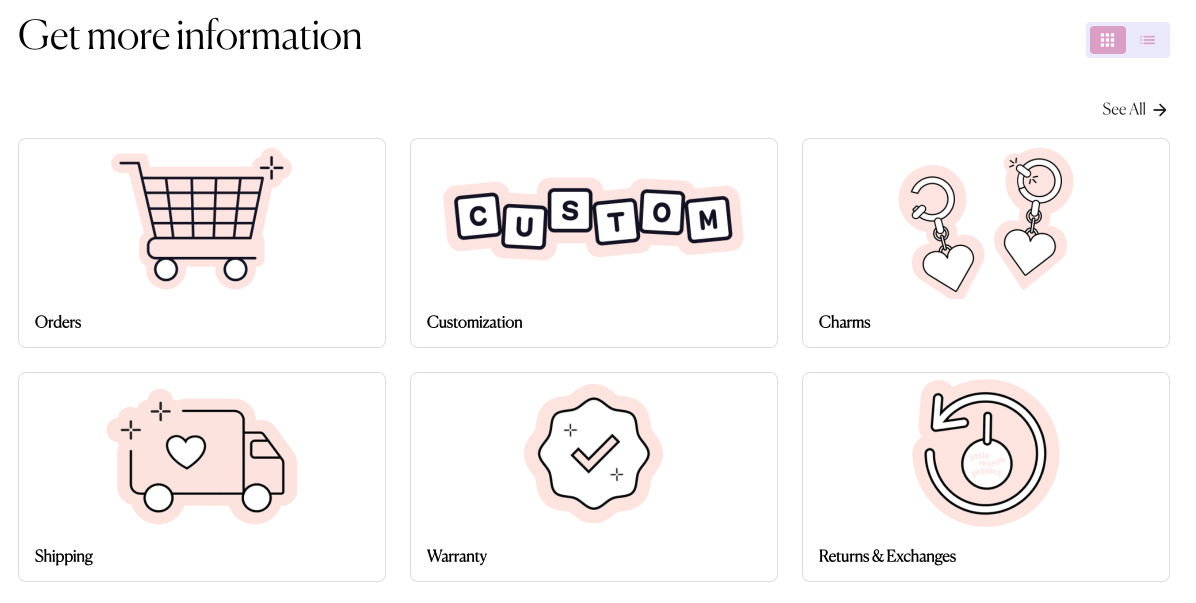
Dr. Bronner’s: Making tools work for the team
Customer education is at the heart of Dr. Bronner’s mission. Their customers often ask detailed questions about product ingredients, packaging, and certifications. With Gorgias, Emily and her team were able to build a robust Help Center that helped to proactively give this information.
The Help Center doesn't just provide information. The integration of interactive Flows, Order Management, and a Contact Form automation allowed Dr. Bronner’s to handle routine inquiries—such as order statuses—quickly and efficiently. These kinds of interactive elements are all possible out-of-the-box, no IT support needed.
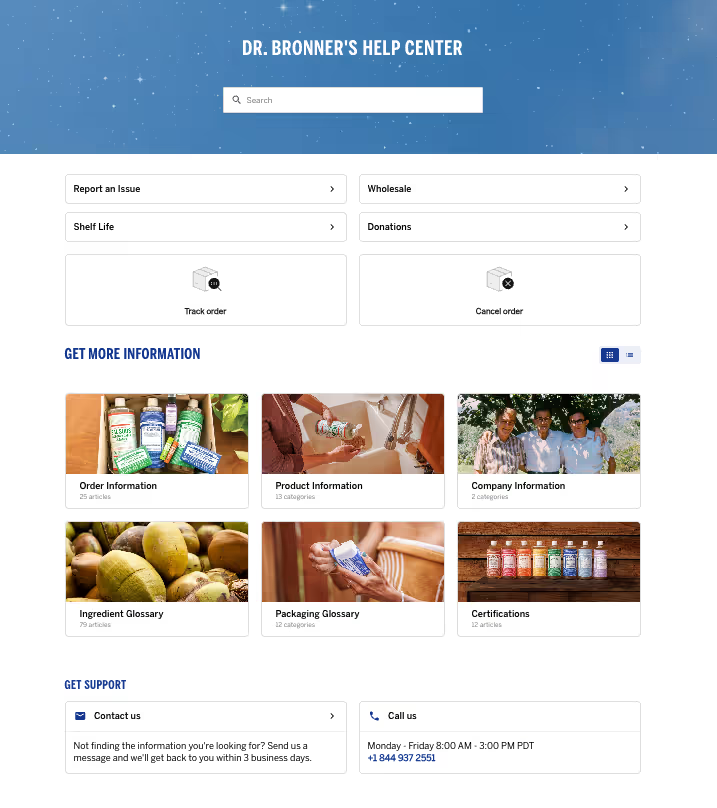
Ekster: Building efficiency through automation and clarity

When Ekster switched to Gorgias, the team wanted to make their Help Center work smarter. By writing clear, structured articles for common questions like order tracking, returns, and product details, they gave both customers and AI Agent the information needed to resolve issues instantly.
"Our previous Help Center solution was the worst. I hated it. Then I saw Gorgias’s Help Center features, and how the Article Recommendations could answer shoppers’ questions instantly, and I loved it. I thought: this is just what we need." —Shauna Cleary, Head of Ecommerce at Ekster
The results followed fast. With well-organized Help Center content and automation built around it, Ekster was able to scale support without expanding the team.
“With all the automations we’ve set up in Gorgias, and because our team in Buenos Aires has ramped up, we didn’t have to rehire any extra agents.” —Shauna Cleary, Head of Ecommerce at Ekster
Learn more: How Ekster used automation to cover the workload of 4 agents
Rowan: Clean structure that keeps customers (and AI) on track
Rowan’s Help Center is a great example of how clear structure can do the heavy lifting. Their FAQs are grouped into simple categories like piercing, shipping, returns, and aftercare, so readers and AI Agent can jump straight to the right topic without digging.
For LLMs, that kind of consistency reduces guesswork. For customers, it creates a smooth, reassuring self-service experience.
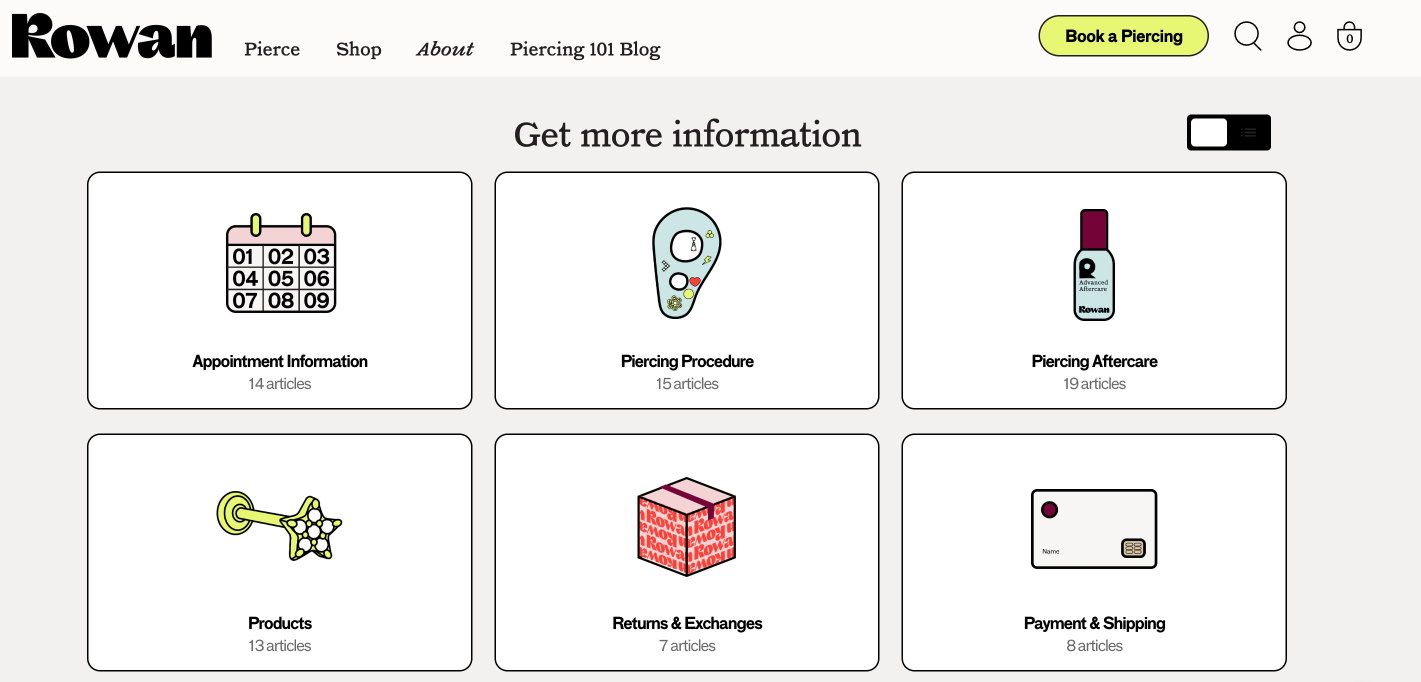
TUSHY: Balancing brand voice with automation
TUSHY proves you can maintain personality and structure. Their Help Center articles use clear headings, direct language, and brand-consistent tone. It makes it easy for AI Agent to give accurate, on-brand responses.
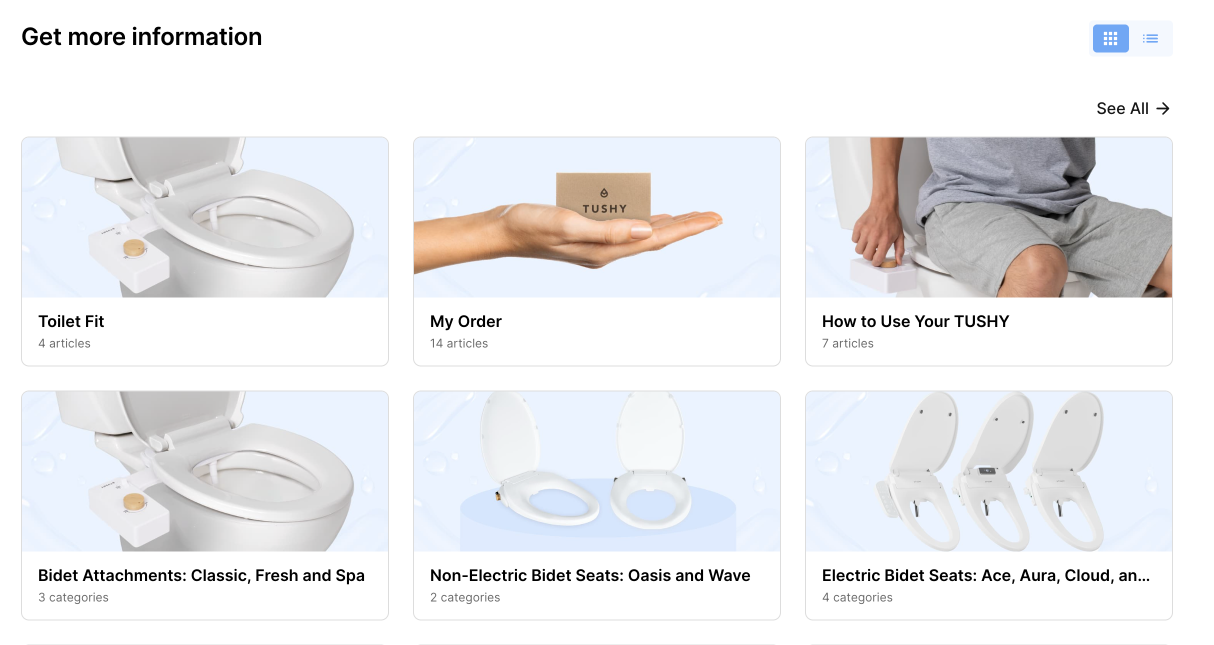
“Too often, a great interaction is diminished when a customer feels reduced to just another transaction. With AI, we let the tech handle the selling, unabashedly, if needed, so our future customers can ask anything, even the questions they might be too shy to bring up with a human. In the end, everybody wins!" —Ren Fuller-Wasserman, Senior Director of Customer Experience at TUSHY
Quick checklist to audit your Help Center for AI
Ready to put your Help Center to the test? Use this five-point checklist to make sure your content is easy for both customers and AI to navigate.
1. Are your articles scannable with clear headings?
Break up long text blocks and use descriptive headers (H2s, H3s) so readers and AI Agent can instantly find the right section.
2. Do you define conditions with “if/when/then” phrasing?
Spell out what happens in each scenario. This logic helps AI Agent decide the right next step without second-guessing.
3. Do you cover your top escalation topics?
Make sure your Help Center includes complete, structured articles for high-volume issues like order status, returns, and refunds.
4. Does each article end with a clear next step or link?
Close every piece with a call to action, like a form, related article, or support link, so neither AI nor customers hit a dead end.
5. Is your language simple, action-based, and consistent?
Use direct, predictable phrasing. Avoid filler like “Don’t worry!” and focus on steps customers can actually take.
By tweaking structure instead of your content, it’s easier to turn your Help Center into a self-service powerhouse for both customers and your AI Agent.
Make your Help Center work smarter
Your Help Center already holds the answers your customers need. Now it’s time to make sure AI can find them. A few small tweaks to structure and phrasing can turn your existing content into a powerful, AI-ready knowledge base.
If you’re not sure where to start, review your Help Center with your Gorgias rep or CX team. They can help you identify quick wins and show you how AI Agent pulls information from your articles.
Remember: AI Agent gets smarter with every structured doc you publish.
Ready to optimize your Help Center for faster, more accurate support? Book a demo today.
{{lead-magnet-2}}
Newsletter Signup
The best in CX and ecommerce, right to your inbox
Featured articles

How to Prep for Peak Season: BFCM Automation Checklist
TL;DR:
- Start by cleaning up your Help Center. Update your articles based on last year’s data, using plain language and clear policy details to boost self-service.
- Use automations to streamline ticket routing and support efficiency. Set rules for tagging, escalation, and inbox views, so your team can respond faster.
- Prep your macros, AI, and staffing plan in advance. Build responses for top FAQs, train AI on the right sources, and forecast agent needs to avoid burnout.
- Automate logistics, upselling, and QA to stay ahead. From showing shipping timelines to flagging low-quality responses, automation ensures smooth operations and more revenue during peak season.
Getting ready for that yearly ticket surge isn’t only about activating every automation feature on your helpdesk, it’s about increasing efficiency across your entire support operations.
This year, we’re giving you one less thing to worry about with our 2025 BFCM automation guide. Whether your team needs a tidier Help Center or better ticket routing rules, we’ve got a checklist for every area of the customer experience brought to you by top industry players, including ShipBob, Loop Returns, TalentPop, and more.
{{lead-magnet-1}}
2025 BFCM automation checklist
- Tidy up your Help Center
- Audit your docs
- Review last year’s BFCM data to find your must-have articles
- Update your policy details
- Edit content using easy-to-understand language
- Expedite your ticket routing automations
- Set up automated ticket tags
- Create an inbox view for each category
- Set escalation rules for urgent tickets
- Set up mandatory Ticket Fields
- Prep your macros and AI agent
- Write macros for your top FAQs
- Train your AI on the right sources
- Define the limits of what AI should handle
- Forecast your BFCM staffing needs
- Use ticket volume to estimate the number of agents
- Plan extra coverage with automation or outsourcing
- Run agent training sessions on BFCM protocols
- Map out your logistics processes
- Negotiate better rates and processing efficiencies
- Automate inventory reorder points
- Build contingency plans for disruptions
- Show shipping timelines on product pages
- Maximize profits with upselling automations
- Guide shoppers with smart recommendations
- Suggest alternatives when items are out of stock
- Engage hesitant shoppers with winback discounts
- Keep support quality high with QA automations
- Automate ticket reviews with AI-powered QA
- Track both agent and AI responses
- Turn QA insights into coaching opportunities
Tidy up your Help Center
Your customer knowledge base, FAQs, or Help Center is a valuable hub of answers for customers’ most asked questions. For those who prefer to self-serve, it’s one of the first resources they visit. To ensure customers get accurate answers, do the following:
- Audit your docs
- Review last year’s BFCM data to find your must-have articles
- Update your policy details
- Edit content using easy-to-understand language
1. Audit your docs
Take stock of what’s currently in your database. Are you still displaying low-engagement or unhelpful articles? Are articles about discontinued products still up? Start by removing outdated content first, and then decide which articles to keep from there.
Related: How to refresh your Help Center: A step-by-step guide
2. Review last year’s BFCM data to find your must-have articles
Are you missing key topics, or don’t have a database yet? Look at last year’s tickets. What were customers’ top concerns? Were customers always asking about returns? Was there an uptick in free shipping questions? If an inquiry repeats itself, it’s a sign to add it to your Help Center.
3. Update your policy details
An influx of customers means more people using your shipping, returns, exchanges, and discount policies. Make sure these have accurate information about eligibility, conditions, and grace periods, so your customers have one reliable source of truth.
Personalization tip: Loop Returns advises adjusting your return policy for different return reasons. With Loop’s Workflows, you can automatically determine which customers and which return reasons should get which return policies.
Read more: Store policies by industry, explained: What to include for every vertical
4. Edit content using easy-to-understand language
Customers want fast answers, so ensure your docs are easy to read and understand. Titles and answers should be clear. Avoid technical jargon and stick to simple sentences that express one idea. To accelerate the process, use AI tools like Grammarly and ChatGPT.
No time to set up a Help Center? Gorgias automatically generates Help Center articles for you based on what people are asking in your inbox.

Expedite your ticket routing automations
Think of ticket routing like running a city. Cars are your tickets (and customers), roads are your inboxes, and traffic lights are your automations and rules. The better you maintain these structures, the better they can run on their own without needing constant repairs from your CX team.
Here’s your ticket routing automation checklist:
- Tag every ticket
- Create views for each category you need (VIP, Returns, Troubleshooting, etc.)
- Set escalation rules for urgent tickets
- Set up mandatory Ticket Fields
1. Set up automated ticket tags
Instead of asking agents to tag every ticket, set rules that apply tags based on keywords, order details, or message type. A good starting point is to tag tickets by order status, returns, refunds, VIP customers, and urgent issues so your team can prioritize quickly.
Luckily, many helpdesks offer AI-powered tags or contact reasons to reduce manual work. For example, Gorgias automatically detects a ticket’s Contact Reason. The system learns from past interactions, tagging your tickets with more accuracy each time.

2. Create an inbox view for each category
Custom or filtered inbox views give your agents a filtered and focused workspace. Start with essential views like VIP customers, returns, and damages, then add specialized views that match how your team works.
If you’re using conversational AI to answer tickets, views become even more powerful. For example, you might track low CSAT tickets to catch where AI responses fall short or high handover rates to identify AI knowledge gaps. The goal is to reduce clutter so agents can focus on delivering support.
3. Set escalation rules for urgent tickets
Don’t get bogged down in minor issues while urgent tickets sit unanswered. Escalation rules make sure urgent cases are pushed to the top of your inbox, so they don’t risk revenue or lead to unhappy customers.
Tickets to escalate to agents or specialized queues:
- Lost packages
- Damaged items
- Defective items
- Failed payments
- Open tickets without a follow-up
4. Set up mandatory Ticket Fields to get data right off the bat
Ticket Fields add structure by requiring your team to capture key data before closing a ticket. For BFCM, make fields like Contact Reason, Resolution, and Return Reason mandatory so you always know why customers reached out and how the issue was resolved.
For CX leads, Ticket Fields removes guesswork. Instead of sifting through tickets one by one, you’ll have clean data to spot trends, report on sales drivers, and train your team.
Pro Tip: Use conditional fields to dig deeper without overwhelming agents. For example, if the contact reason is “Return,” automatically prompt the agent to log the return reason or product defect.
Prep your macros and AI agent
Macros and AI Agent are your frontline during BFCM. When prepped properly, they can clear hundreds of repetitive tickets. The key is to ensure that answers are accurate, up-to-date, and aligned with what you want AI to handle.
- Write macros for your most common FAQs
- Train your AI on the right sources
- Define the limits of what AI should handle
1. Write macros for your top FAQs
Customers will flood your inbox with the same questions: “Where’s my order?” “When will my discount apply?” “What’s your return policy?” Write macros that give short, direct answers up front, include links for details, and use placeholders for personalization.
Bad macro:
- “You can track your order with the tracking link. It should update soon.”
Good macro:
- “Hi {{customer_firstname}}, you can track your order here: {{tracking_link}}. Tracking updates may take up to 24 hours to appear. Here’s our shipping policy: [Help Center link].”
Pro Tip: Customers expect deep discounts this time of year. BPO agency C(x)atalyze recommends automating responses to these inquiries with Gorgias Rules. Include words such as “discount” AND “BFCM”, “holiday”, “Thanksgiving”, “Black Friday”, “Christmas”, etc.
2. Train your AI on the right sources
AI is only as good as the information you feed it. Before BFCM, make sure it’s pulling from:
- Your Help Center with updated FAQs and policies
- Internal docs on return windows, promos, and shipping cutoffs
- Product catalogs with the latest details and stock info
- BFCM-specific resources like discount terms or extended support hours
Double-check a few responses in Test Mode to confirm the AI is pulling the right information.

3. Define the limits of what AI should handle
Edge cases and urgent questions need a human touch, not an automated reply. Keep AI focused on quick requests like order status, shipping timelines, or promo eligibility. Complex issues, like defective products, VIP complaints, and returns, can directly go to your agents.
Pro Tip: In Gorgias AI Agent settings, you can customize how handovers happen on Chat during business hours and after hours.
Forecast your BFCM staffing needs
Too few agents and you prolong wait times and miss sales. Too many and you’ll leave your team burned out. Capacity planning helps you find the balance to handle the BFCM surge.
1. Use ticket volume to estimate the number of agents
Use your ticket-to-order ratio from last year as a baseline, then apply it to this year’s forecast. Compare that number against what your team can realistically handle per shift to see if your current staffing plan holds up.
Read more: How to forecast customer service hiring needs ahead of BFCM
2. Plan extra coverage with automation or outsourcing
You still have options if you don’t have enough agents helping you out. Customer service agency TalentPop recommends starting by identifying where coverage will fall short, whether that’s evenings, weekends, or specific channels. Then decide whether to increase automation and AI use or bring in temporary assistance.
3. Run agent training sessions on BFCM protocols
Before the holiday season, run refreshers on new products, promos, and policy changes so no one hesitates when the tickets roll in. Pair training with cheat sheets or an internal knowledge base, giving your team quick access to the answers they’ll need most often.
Map out your logistics processes
Expect late shipments, low inventory, and more returns than usual during peak season. With the proper logistics automations, you can stay ahead of these issues while reducing pressure on your team.
ShipBob and Loop recommend the following steps:
- Negotiate better rates and processing efficiencies
- Automate your reverse logistics
- Connect your store, 3PL, and WMS
- Automate inventory reorder points
- Show shipping timelines on product pages
1. Negotiate better rates and processing efficiencies
Shipping costs add up fast during peak season. Work with your 3PL or partners like Loop Returns to take advantage of negotiated carrier rates and rate shopping tools that automatically select the most cost-effective option for each order.
2. Automate inventory reorder points
To maintain a steady supply of products, set automatic reorder points at the SKU level so reorders are triggered once inventory dips below a threshold. More lead time means fewer ‘out of stock’ surprises for your customers.
3. Build contingency plans for disruptions
Bad weather, delays, or unexpected demand can disrupt shipping timelines. Create a playbook in advance so your team knows exactly how to respond when things go sideways. At minimum, your plan should cover:
- Weather disruptions - Do you have a backup plan if carriers can’t pick up shipments due to storms or severe conditions?
- Carrier overloads - Which alternative carriers or routes can you switch to if primary partners are at capacity?
- Inventory shortages - How will you handle overselling, low stock alerts, or warehouse imbalances?
- Demand drop-offs - How will you reallocate inventory if BFCM sales don’t match forecasts?
4. Show shipping timelines on product pages
Customers want to know when their order will arrive before they hit checkout. Add estimated delivery dates and 2-day shipping badges directly on product pages. These cues help shoppers make confident decisions and reduce pre-purchase questions about shipping times.
Pro Tip: To keep those timelines accurate, build carrier cutoff dates into your Black Friday logistics workflows with your 3PL or fulfillment team. This allows you to avoid promising delivery windows your carriers can’t meet during peak season.
Maximize profits with upselling automations
You’ve handled the basics, from ticket routing to staffing and logistics. Now it’s time to go beyond survival. Upselling automations create an end-to-end experience that enhances the customer journey, shows them products they’ll love, and makes it easy to buy more with confidence. To put them to work:
- Guide shoppers with smart recommendations
- Suggest alternatives when items are out of stock
- Engage hesitant shoppers with winback discounts
1. Guide shoppers with smart recommendations
BFCM puts pressure on customers to find the right deal fast, but many don’t know what they’re looking for. Make it easier for them with macros that point shoppers to bestsellers or curated bundles. For a more advanced option, conversational AI like Gorgias Shopping Assistant can guide browsers on their own, even when your agents are offline.
2. Suggest alternatives when items are out of stock
No need to damage your conversion rate just because customers missed the items they wanted. Automations can recommend similar or complementary products, keeping customers engaged rather than leaving them empty-handed.
If an item is sold out, set up automations to:
- Suggest similar items like another size, color, or variation of the same product.
- Highlight premium upgrades such as a newer model or higher-value version that’s in stock.
- Cross-sell and offer bundles to keep the order valuable even without the original item.
- Notify customers about restocks by letting shoppers sign up for back-in-stock alerts.
3. Engage hesitant customers with winback discounts
Automations can detect hesitation through signals like abandoned carts, long checkout times, or even customer messages that mention keywords such as “too expensive” or “I’ll think about it.” In these cases, trigger a small discount to encourage the purchase.
You can take this a step further with conversational AI like Gorgias Shopping Assistant, which detects intent in real time. If a shopper seems uncertain, it can proactively offer a discount code based on the level of their buying intent.
Keep support quality high with QA automations
During BFCM, speed alone is not enough. Customers expect accurate, helpful, and on-brand responses, even when volume is at its highest. QA automations help you prioritize quality by reviewing every interaction automatically and flagging where standards are slipping. To make QA part of your automation prep:
- Automate ticket reviews with AI-powered QA
- Track both agent and AI responses
- Turn QA insights into coaching opportunities
1. Automate ticket reviews with AI-powered QA
Manual QA can only spot-check a small sample of tickets, which means most interactions go unreviewed. AI QA reviews every ticket automatically and delivers feedback instantly. This ensures consistent quality, even when your team is flooded with requests.
Compared to manual QA, AI QA offers:
- Full coverage: Every ticket is reviewed, not just a sample.
- Instant feedback: Agents get insights right after closing tickets.
- Consistency: Reviews are unbiased and use the same criteria across all interactions.
- Scalability: Works at any ticket volume without slowing down your team.
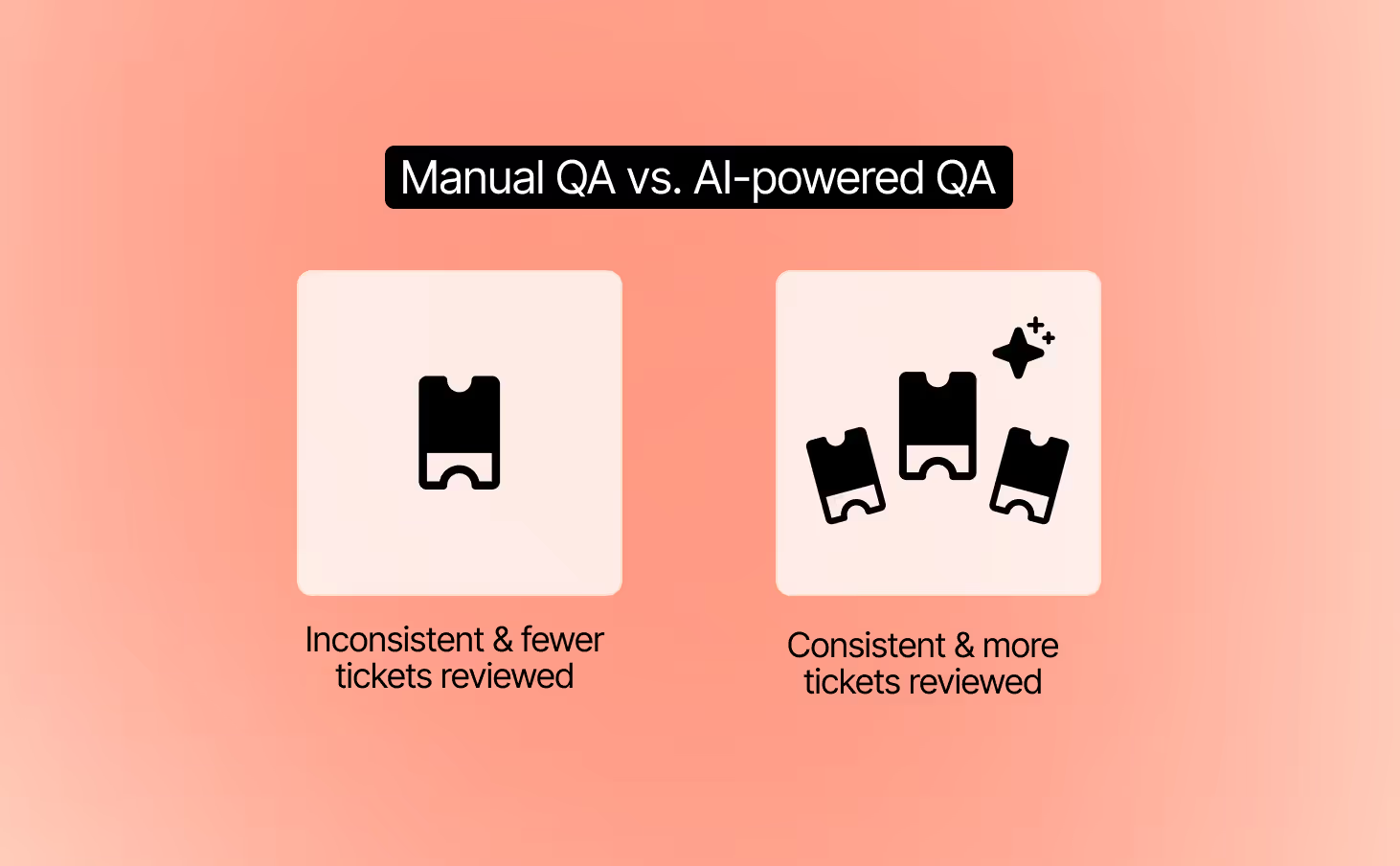
2. Track both agent and AI responses
Customers should get the same level of quality no matter who replies. AI QA evaluates both human and AI conversations using the same criteria. This creates a fair standard and gives you confidence that every interaction meets your brand’s bar for quality.
3. Turn QA insights into coaching opportunities
QA automation is not just about grading tickets. It highlights recurring issues, unclear workflows, or policy confusion. Use these insights to guide targeted coaching sessions and refine AI guidance so both humans and AI deliver better results.
Pro Tip: Pilot your AI QA tool with a small group of agents before peak season. This lets you validate feedback quality and scale with confidence when BFCM volume hits.
Give your ecommerce strategy a boost this holiday shopping season
The name of the game this Black Friday-Cyber Monday isn’t just to get a ton of online sales, it’s to set up your site for a successful holiday shopping season.
If you want to move the meter, focus on setting up strong BFCM automation flows now.
Gorgias is designed with ecommerce merchants in mind. Find out how Gorgias’s time-saving CX platform can help you create BFCM success. Book a demo today.
{{lead-magnet-2}}
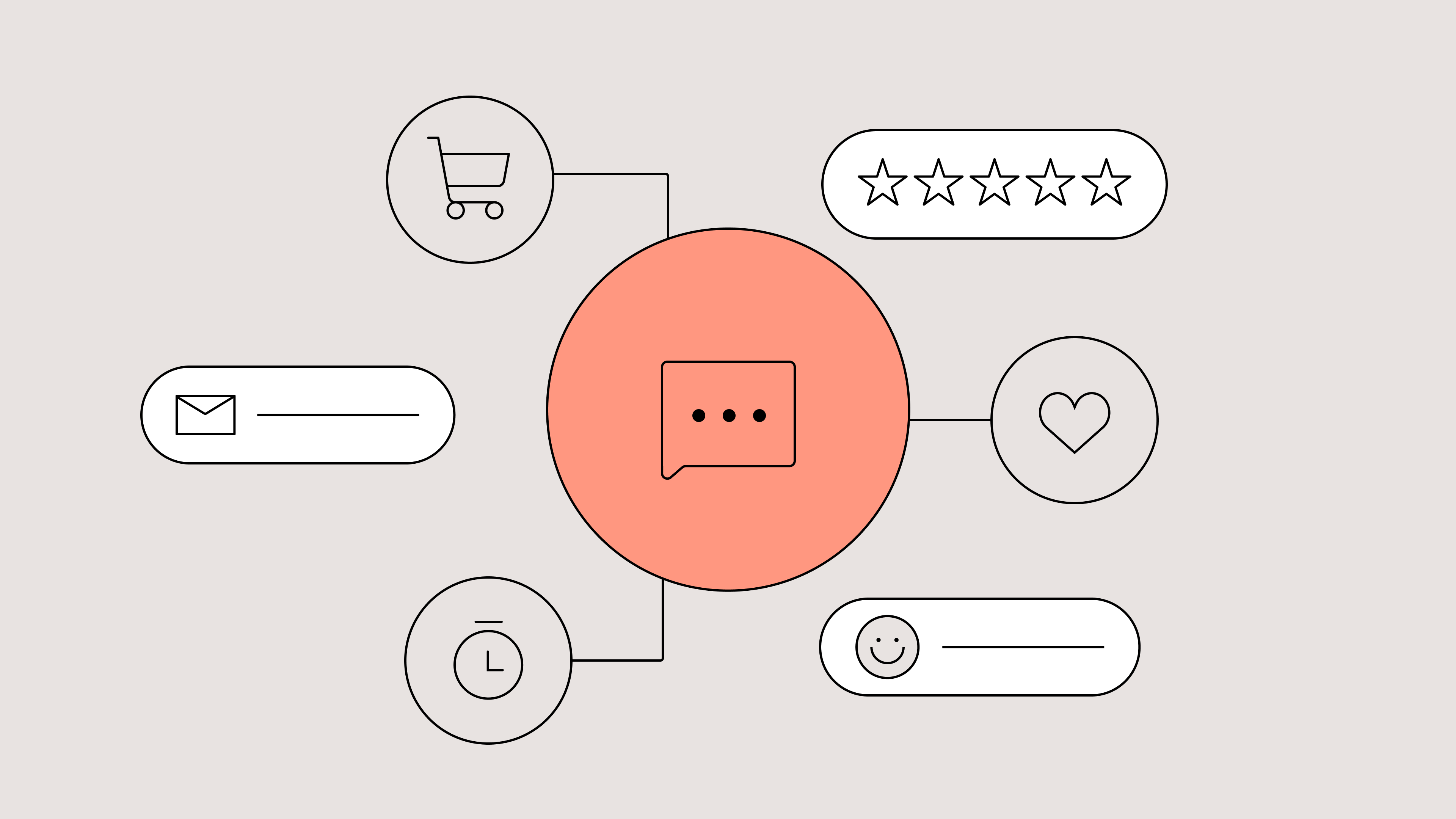
The Power of Suggestion: Why Subtle Cues Create Better Conversations
TL;DR:
- Suggestion turns browsing into buying by gently guiding action instead of forcing it.
- Fewer, clearer choices reduce decision fatigue and help shoppers move forward with confidence.
- A well-timed prompt with a friendly tone can make automation feel like a real conversation.
- Good design earns trust by being subtle, approachable, and easy to engage with.
- Small, thoughtful cues create moments of connection that make shoppers feel understood.
Shopping today isn’t a linear funnel. It’s a fluid conversation. Browse → question → help → buy → return → repeat.
Every step is a dialogue between the shopper’s intent and the brand’s response.
But what bridges the gap between “just looking” and “I’m buying” isn’t persuasion or urgency — it’s suggestion: the subtle design, timing, and language cues that guide action without forcing it.
When done well, suggestion becomes the architecture of trust. It’s also the best way to make AI-powered experiences feel human-first, not tech-first.
This article explores how the power of suggestion — rooted in behavioral psychology and UX design — shapes modern conversational commerce.
{{lead-magnet-1}}
Why suggestion matters in the age of conversational commerce
The average ecommerce shopper faces thousands of micro-decisions from the moment they land on a site. Which product? Which variant? Which review to trust? Which shipping method? Each one adds cognitive weight.
Psychologist Barry Schwartz coined the term The Paradox of Choice to describe how abundance often leads to paralysis. In his research, participants faced with too many options were less likely to make a choice and less satisfied when they did.
In ecommerce, that means overload costs conversions. When shoppers must evaluate too many variables, they hesitate, second-guess, or abandon.
Shoppers today expect empathy and ease, not persuasion. When you suggest rather than push, you signal empathy and support.
This is especially important for conversational commerce. Suggestion humanizes automation by making AI interactions feel like conversations rather than transactions.
When you push and persuade, you create a memorable experience for customers — but it’s not the kind you want them to remember.
One Reddit thread perfectly captures the problem: a user tried to cancel their Thrive Market membership and had to ask nine times before the chatbot complied.
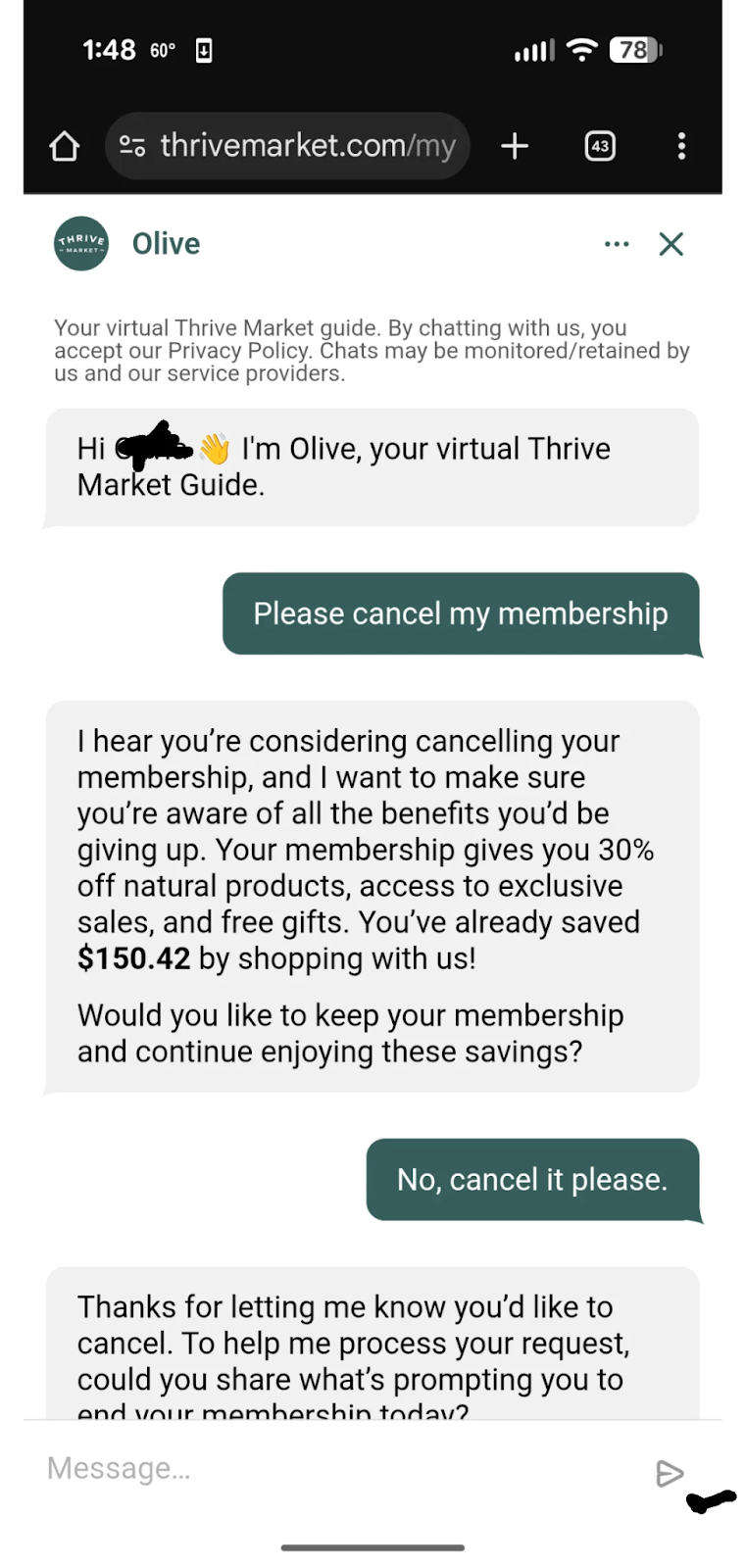
Each time, the AI assistant tried to talk them out of it (offering deals, guilt-tripping responses, or irrelevant messages) until the customer’s frustration boiled over.
The thread exploded not just because it was mildly infuriating, but because it illustrated what customers fear most about automation: a lack of empathy.
Suggestion is how you design for trust, ease, and interaction. And for ecommerce and CX professionals, suggestion bridges browsing and buying by prompting dialogue in a gentle, psychologically sound way.
5 ways to use suggestion with agentic AI
The magic of suggestion is that it works with human psychology, not against it. It bridges the space between what a shopper wants to do and what helps them do it.
That’s the foundation of the Fogg Behavior Model, developed by Stanford’s Dr. BJ Fogg. The model states that behavior happens when three things intersect:
- Motivation — the user wants to do something.
- Ability — they can do it easily.
- Prompt — they’re nudged at the right moment.
When these three align, the likelihood of action skyrockets.
In conversational commerce, suggestion is the gentle push that turns intent into interaction.
Below are five ways to apply suggestion with agentic AI (think chat, assistants, and marketing tools) to drive trust, dialogue, and conversion.
1. Build trust with a friendly invitation
A first impression shapes the entire interaction.
A greeting like “Need help?” or “Looking for something special?” signals availability without applying pressure. It’s the digital equivalent of a store associate smiling and saying, “Let me know if you need anything.”
This works because of linguistic framing, which is a form of persuasive language that subtly shapes how people interpret intent.
- Sentences using personal pronouns (“you,” “we”) increase perceived warmth and empathy.
- Questions (vs. imperatives) activate a conversational schema in the brain, inviting a cooperative response.
- Short, low-stakes phrasing signals that engagement is voluntary.
In practice, this means:
- Replace “Start chat now” with “Need a hand finding the right fit?”
- Use punctuation and tone cues that convey friendliness.
- Let the chat invite linger rather than pop up suddenly — this gives users agency.
Take a look at Glamnetic. Its shopping assistant sits at the bottom-right corner of every page. While shoppers scroll on the homepage, a prompt appears: “Shop with AI.” It’s transparent about being an AI chat, but subtle enough to be there for shoppers when they’re ready to use it at their own leisure.
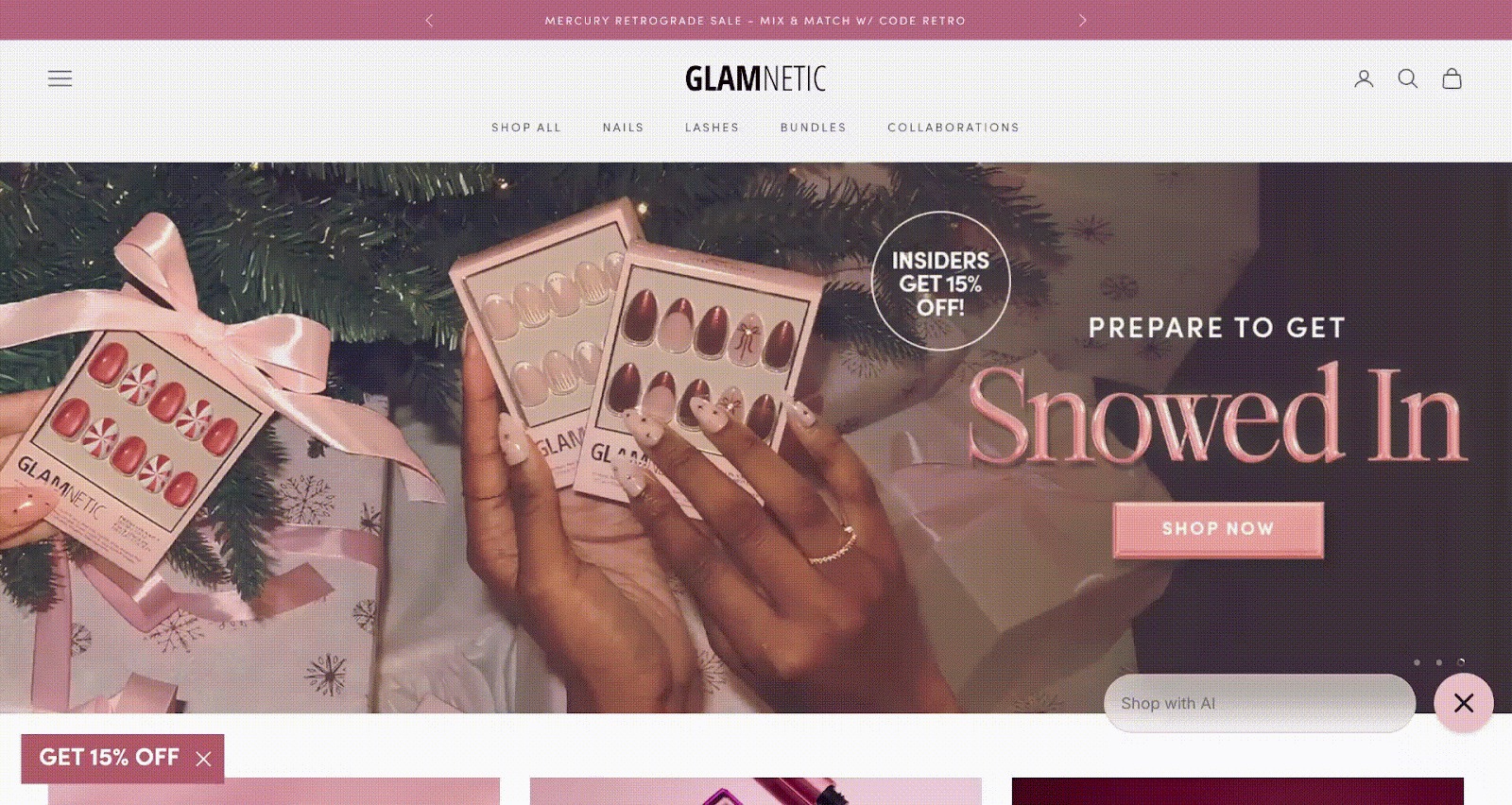
Gorgias Shopping Assistant is an easy way to do this. At the right moment, Shopping Assistant appears with a greeting such as “Need help?” or “Chat with our AI!” It’s friendly, low-pressure, optional, more “Hey I’m here if you need” than “Buy now!”
2. Make decisions easier by offering fewer choices
If you’ve ever scrolled through 80 product filters and given up, you’ve experienced choice overload. This is the Paradox of Choice in action:
More options = higher cognitive effort = lower satisfaction.
Suggestion works because it reduces mental effort. When an AI assistant limits quick-reply options to just a few (say, “Long sleeve,” “Short sleeve,” “Sleeveless”), it transforms chaos into clarity.
Each small tap provides forward momentum, a concept known as the goal-gradient effect: the closer we feel to completing a goal, the faster and more positively we act.
How can you apply this to agentic AI?
- Keep quick replies between 3–5 choices — enough to feel personalized, not overwhelming.
- Present them as progressive steps, not isolated decisions (e.g., “Show me styles” → “Show me colors” → “Add to cart”).
- Always include a “Something else” or “Other” option to preserve user autonomy.
- Refresh options dynamically based on prior selections — a technique known as choice scaffolding.
Gorgias’s Shopping Assistant does this well, surfacing only the most relevant next steps. Instead of forcing open-ended typing, it guides shoppers through mini-decisions that build confidence. Here’s an example from Okanui, showing four clear options to reply to Shopping Assistant.
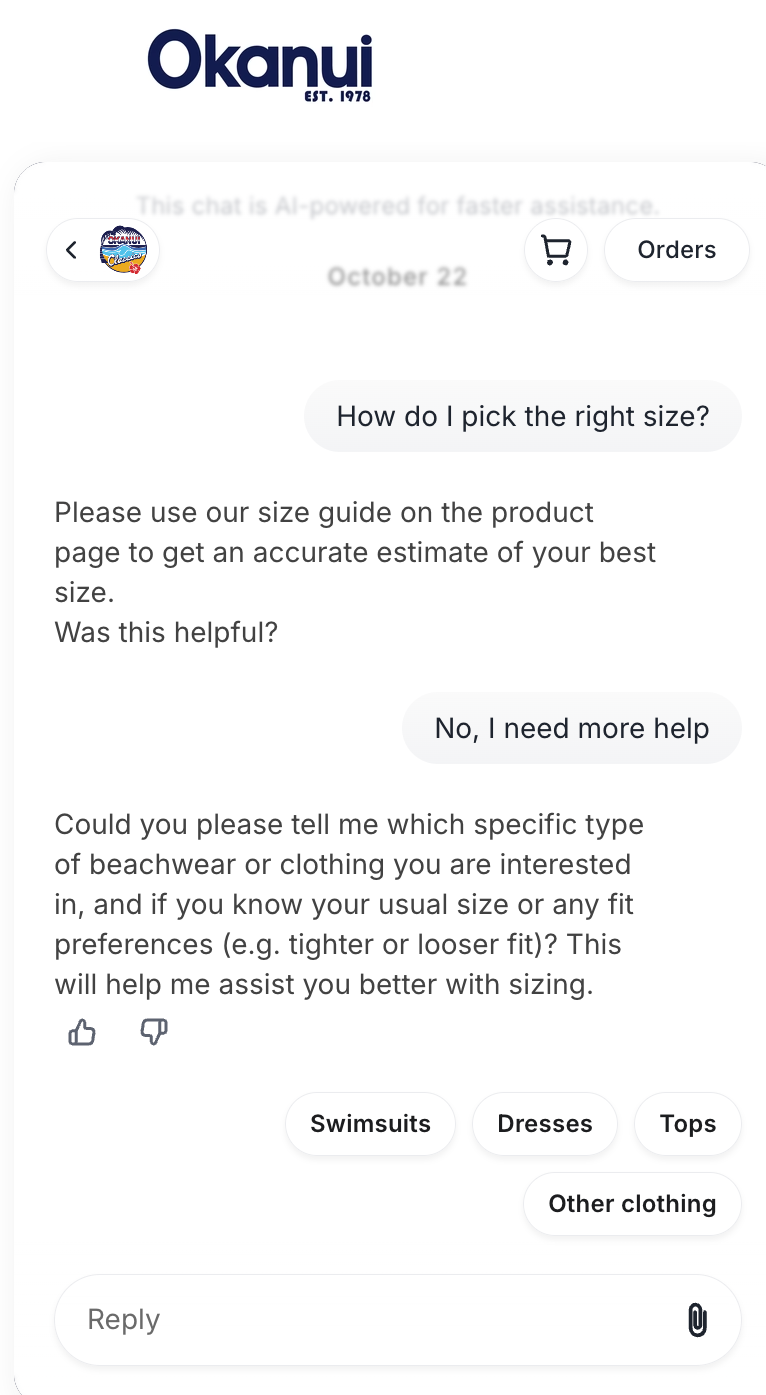
3. Encourage interaction with a user-friendly design
Before a shopper reads a single word of text, their brain has already judged whether your interface feels safe to engage with.
That’s the Aesthetic–Usability Effect — when people perceive something as visually appealing, they assume it will be easier and more trustworthy to use.
Design psychologist Don Norman put it best: “Attractive things work better because they make people feel better.”
Here’s why visual subtlety matters:
- Rounded edges and soft shapes signal continuity and friendliness (the human brain associates curves with safety; sharp angles with danger).
- Muted palettes and neutral contrast lower visual stress, allowing the interface to fade into the background until needed.
- Micro-animations — like a gentle glow or slide-in — trigger attention without hijacking focus.
- Minimizable elements give users a sense of control, reducing resistance to engagement.
OSEA’s product description page is a beautiful example of unintrusive design in action. The buttons have rounded edges, the 10% offer isn’t covering other page elements, and the chat sits in the bottom-right corner, making it easily accessible if a shopper has questions about the product.
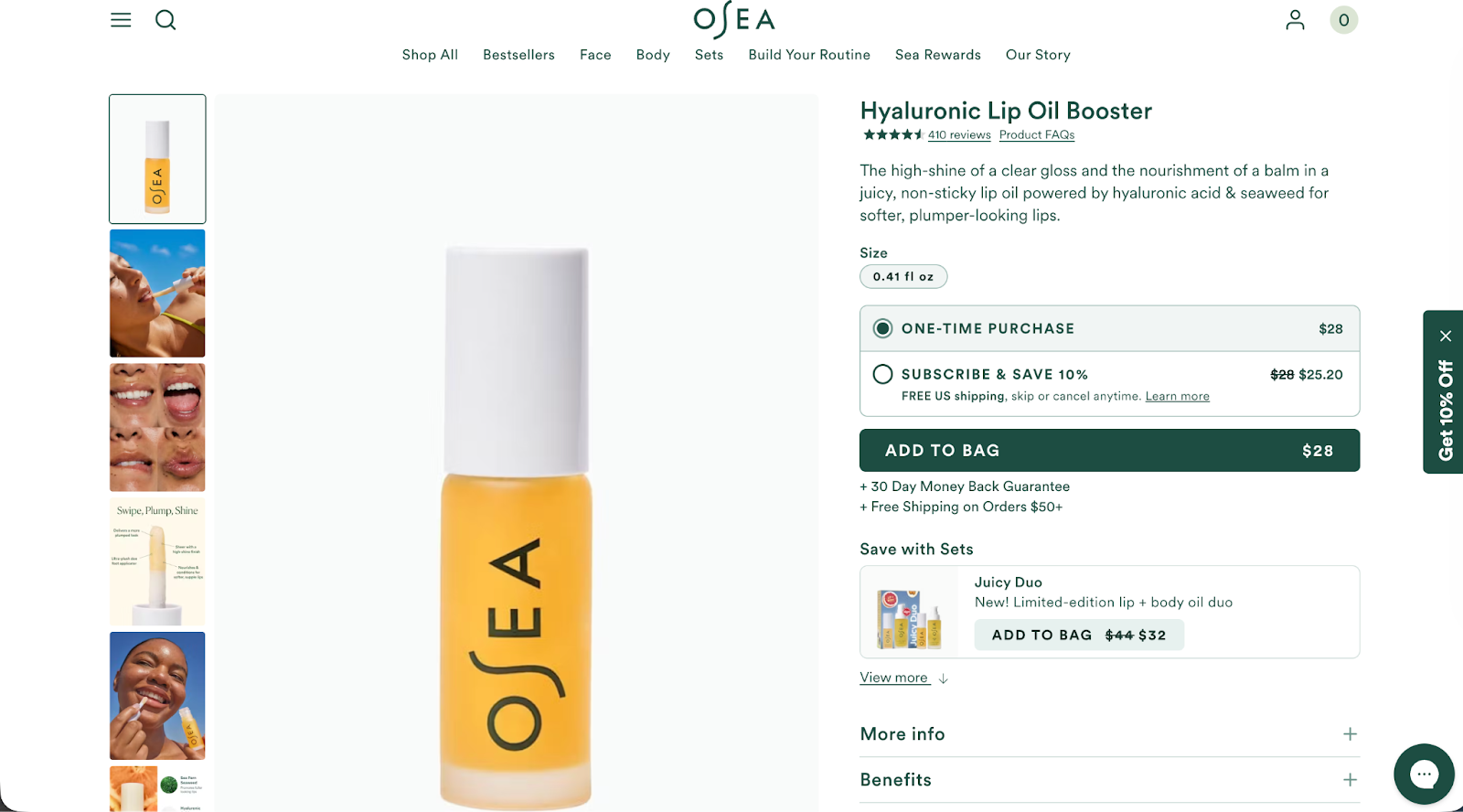
4. Match your timing to the customer’s pace
Timing is everything in suggestion-based design. Even the most thoughtful interaction will fail if it appears at the wrong moment.
That’s where the Fogg Behavior Model becomes tactical: Behavior = Motivation × Ability × Prompt
When shoppers are motivated (interested in a product) and able (engaging is easy), a well-timed prompt (chat bubble, message, or offer) turns potential into action.
But mistime it, and you risk the opposite. A chat that appears too early feels like spam. Too late, and the user’s interest window closes.
Here’s how to align the timing sweet spot:
- Use behavioral triggers: Fire prompts after meaningful engagement (e.g., 25–30 seconds on a product page, reaching 70% scroll depth, or idling for 15 seconds).
- Match prompt to context: Offer size guidance on apparel pages, warranty info near checkout, or live help on return pages.
- Respect frequency: One well-placed nudge beats five redundant ones.
- Localize timing: Adjust based on device and location. Mobile users often need faster cues due to shorter browsing sessions.
Gorgias Shopping Assistant does all of the above. Using context — such as the current page, conversational context, and cart behavior — helps the AI trigger prompts like “Need help choosing a size?” or “Have questions about shipping?”
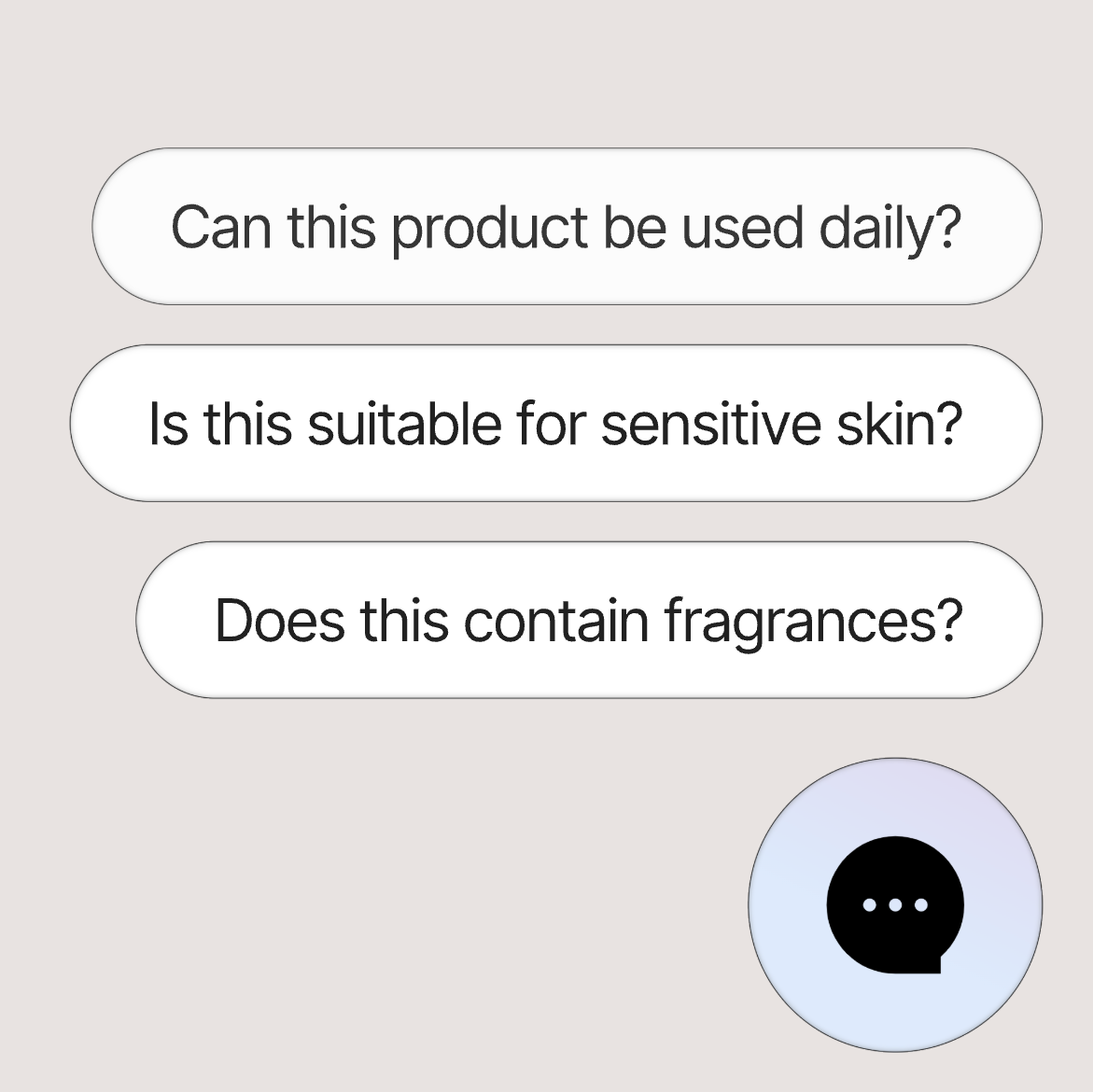
5. Aim to educate, reassure, or inspire — not just sell
Every small suggestion — a phrase, a button shape, a pause, a tone — creates what behavioral economists call a moment of micro-trust.
Individually, these moments may feel insignificant. But together, they turn a static interface into a relationship.
When greeting, choices, design, and timing align, conversation becomes the natural outcome — not the goal. That’s what conversational commerce gets right: it reframes success from “did they convert?” to “did they connect?”
For CX teams, this shift requires designing for the emotional continuity of the experience:
- Did each prompt respect the shopper’s autonomy?
- Did the interaction feel like a two-way exchange?
- Did the system adapt to intent rather than dictate it?
We love this example from Perry Ellis to drive this tip home:

Designing for trust in an age of AI
As AI continues to shape how people shop, brands face a choice: Design for control, or design for trust.
Suggestion is the path to the latter.
The right cue, delivered at the right time, reminds people that even in automated spaces, there’s still room for empathy and understanding.
Gorgias was built on the belief that great commerce starts with conversation, not conversion.
{{lead-magnet-2}}

AI Agent Keeps Getting Smarter (Here’s the Data to Prove It)
TL;DR:
- AI Agent is getting more accurate every month: It’s improved 14.9% this year thanks to better LLMs, constant updates, and user feedback.
- It writes more correctly than most humans: With a 4.77/5 language score, it’s nailing grammar, tone, and clarity better than human agents.
- It’s empathetic, too: AI Agent now shows more empathy and listens better than human agents.
- Brands are gaining confidence fast: Quality scores jumped from 57% to 85% in just a few months, and CX teams are noticing.
- Customers are almost as happy with AI as with humans: AI Agent’s CSAT is just 0.6 points shy of human agents’ average CSAT.
Handing trust over to AI can be intimidating. One off-brand reply and you undo the reputation and customer loyalty you’ve worked so hard to build.
That’s why we’ve made accuracy our top priority with Gorgias AI Agent.
For the past year, the Gorgias team has been hard at work fulfilling the pressing demand for accuracy and speed. AI Agent is getting smarter, faster, and more reliable, and merchants and their customers are happier with the output.
Here’s the data.
{{lead-magnet-1}}
AI Agent delivers more accurate answers than ever
This year, AI Agent’s accuracy rose from 3.55 to 4.08 out of 5, a 14.9% improvement from January. This average score is based on CX agents' ratings of AI Agent responses in the product, on a scale of 1 to 5.
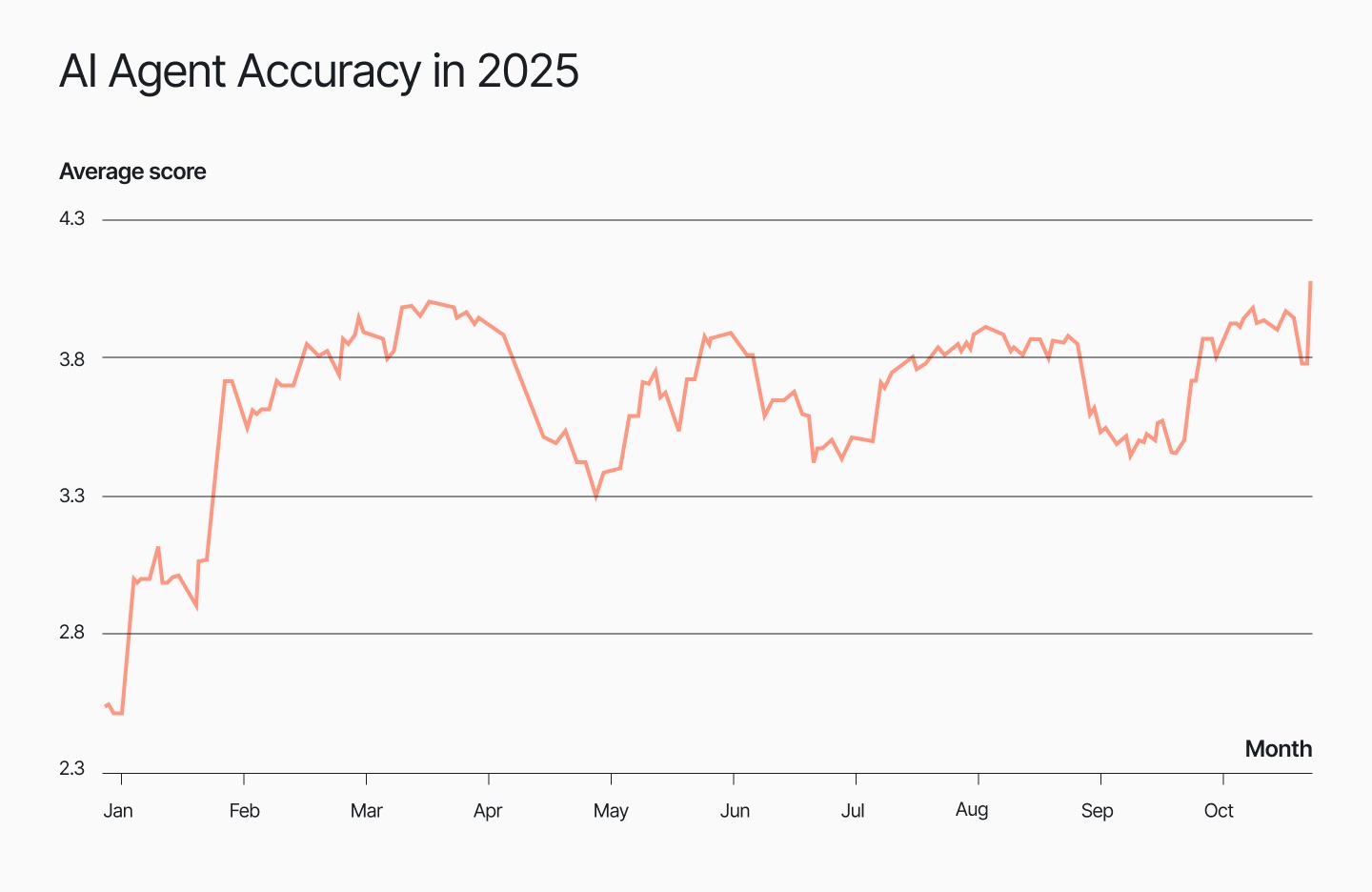
In the past year, we’ve improved knowledge retrieval, added new integrations, expanded reporting features, and asked for more feedback in-product.
We saw the steadiest leap in July, right after the release of GPT-5. AI Agent began reaching levels of consistency and accuracy that agents could trust.
AI Agent writes with more linguistic precision than humans
Clear, easy-to-understand language helps people trust what they’re reading. Website Planet found that 85% more visitors bounced from a page when typos were present. That’s why we’ve made it a priority for AI Agent to respond to customers with correct grammar, syntax, and tone of voice.
The efforts have paid off: AI Agent scores a high 4.77 out of 5 in language proficiency compared to 4.4 for human agents. The result is error-free messages that are easy to read and consistent with your brand vocabulary.
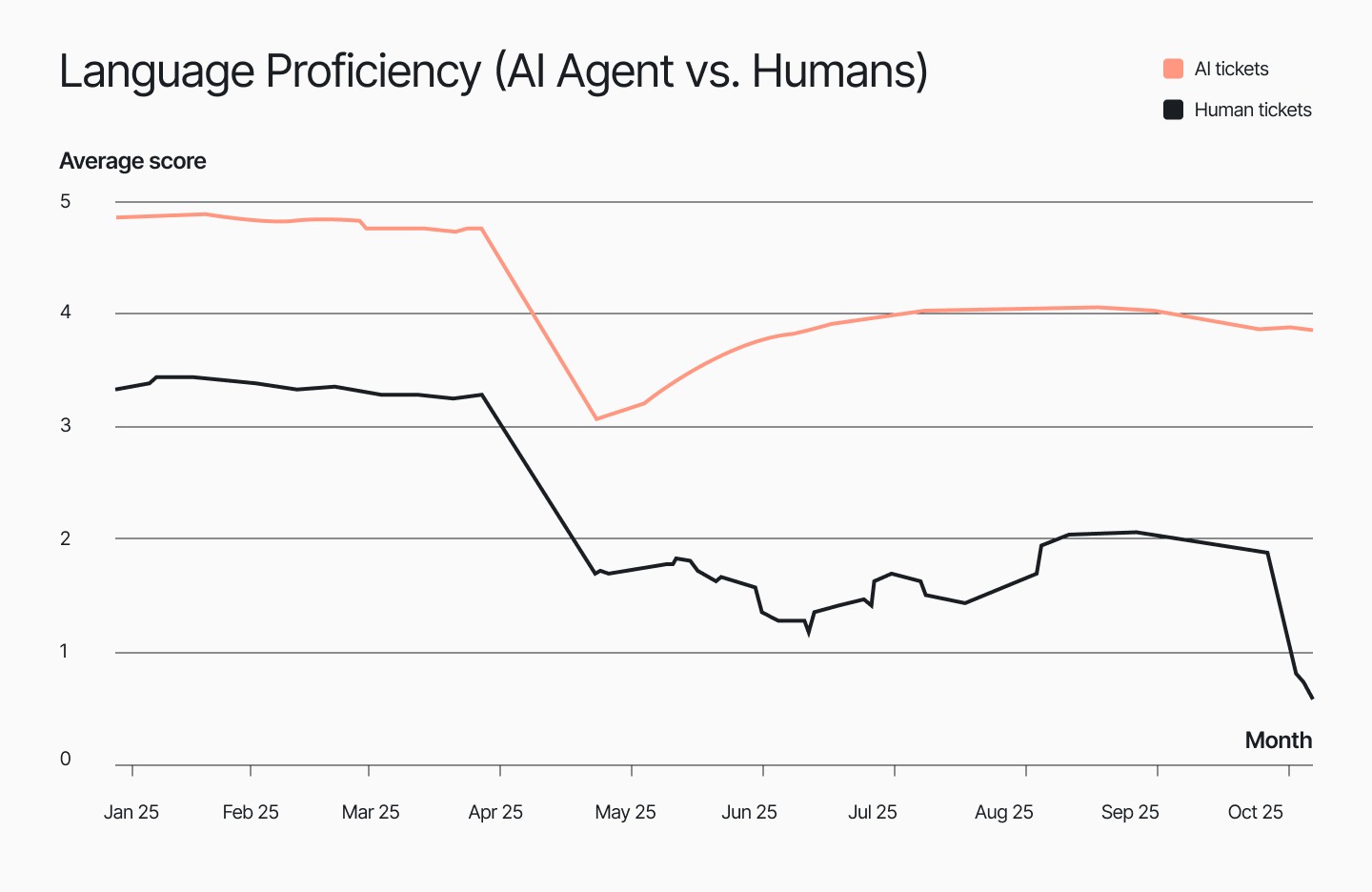
AI Agent shows that empathy can be scaled
Accuracy isn’t just about saying the right thing; it’s also about how a message lands. For that reason, we track AI Agent’s communication quality. Did it reply with empathy? Did it exhibit active listening and respond with clear phrasing?
Recently, AI Agent is even scoring slightly above humans with 4.48 out of 5 in communication, compared to 4.27. This means AI Agent captures the nuance of every message by considering the background context and acknowledging customer frustration before it gives customers a solution.
AI Agent resolves every part of a customer’s question
What happens when a ticket ends without a clear answer? Customers feel neglected and leave the chat still unsure. This can make your brand look out of touch, leaving customers with the lingering feeling that you don’t care.
But don’t worry, we built AI Agent to close that loop every time: AI Agent’s resolution completeness score sits at a perfect 1 out of 1, compared to 0.99 out of 1 for human agents.
In practice, this means customers feel cared for and understood, while your team receives fewer follow-ups, giving them more time to focus on strategic, high-priority tasks.
Read more: A guide to resolution time: How to measure and lower it
Brand confidence is on the rise
Building a great product is a two-way conversation between our engineers and the people who use it. We listen, review feedback, ship changes, and measure what improves.
From January to November 2025, AI Agent quality rose from about 57% to 85%. August was the first big step up, and September kept climbing. Brands are seeing fewer low-quality or incorrect answers and more steady decisions.
This is proof that merchants and their shoppers are witnessing the improvements we’ve been making, for the better.
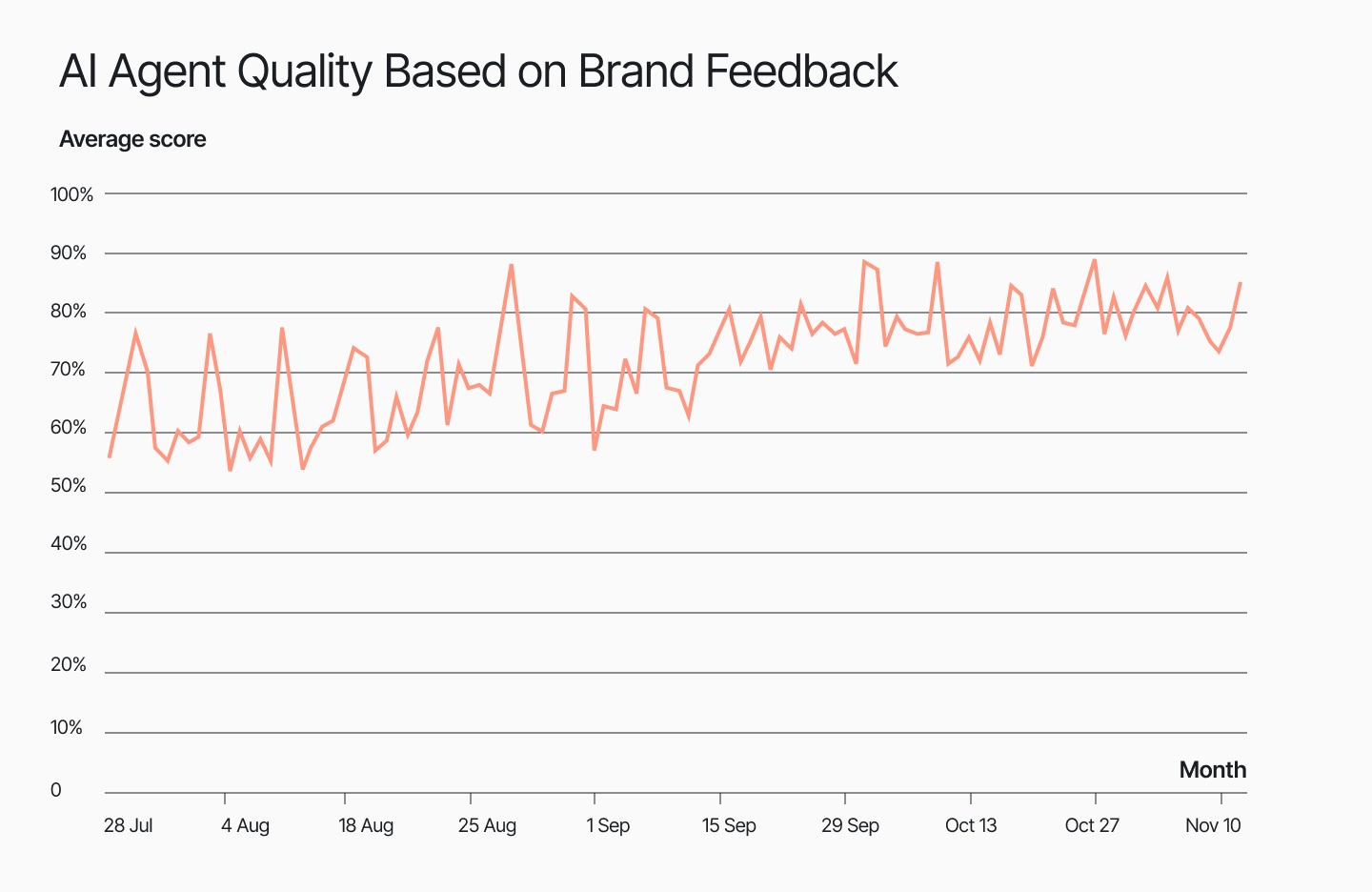
Related: The engineering work that keeps Gorgias running smoothly
Shoppers are rating AI support almost as high as human support
At the end of the day, what matters is how customers feel when they talk to support. Do they trust the answer? Do they find it helpful? Are they running into more friction with AI than without it?
Our data shows that customers are appreciating AI assistance more and more. Since the start of 2025, AI Agent on live chat has gotten a CSAT score 40% closer to the average CSAT of human agents. For email, the gap has narrowed by about 8%.
The goal is to eventually achieve a gap of zero. At this point, AI’s support quality is indistinguishable from that of humans. To get there, we’re focusing on practical improvements like accuracy, clear language, complete answers, and better handoff rules.

How we measure CSAT gap: The CSAT gap is calculated by subtracting AI CSAT from human CSAT. When the number is closer to zero, AI is catching up. When it’s negative, AI is still below human results.
Reliable AI interactions start with accuracy
Behind every accurate AI reply is a team that cares about the details. AI Agent doesn’t make up answers—it follows what you teach it. The more effort your team puts into maintaining an up-to-date Help Center and Guidance, the better the customer experience becomes.
As we look ahead to 2026, we’re focused on fine-tuning knowledge retrieval logic, refining Guidance rules, and continuously learning from feedback from you and your customers.
We’re proud of the strides AI Agent continues to make, and can’t wait for more brands to experience the accuracy for themselves.
Want to see how AI Agent delivers exceptional accuracy without sacrificing speed? Book a demo or start a trial today.
{{lead-magnet-2}}

AI in CX Webinar Recap: Turning AI Implementation into Team Alignment
Further reading

How To Calculate Net Promoter Score: NPS Formula, Tools, & Tips
Businesses run on happy customers. Happy customers generate repeat business, share positive reviews, and refer others to your brand. Plus, happy customers are cost-effective. Getting a new customer typically costs more than keeping your current ones around.
Net promoter score (NPS) measures how likely a customer is to recommend your brand to someone else. This metric was invented by Fred Reichheld of Bain & Company in 2003 and is a surprisingly good indicator of a company’s success. Companies with high NPS for their industry grow revenue 2.5 faster than their competition, according to research from Rob Markey, founder of Bain & Company’s Customer & Marketing practice.
Want to evaluate the success of your customer experience, product, and overall business? You should measure NPS. Here is a closer look at NPS, including how to calculate and benchmark your score.
{{lead-magnet-1}}
What is net promoter score (NPS) and what does it measure?
Net promoter score (NPS) is a metric to calculate the quality of your customer experience across every channel based on whether or not your existing customers are likely to recommend your business to someone else.
The net promoter score for your business is essential because it directly reflects how well your business satisfies your customers. It also shows the number of promoters you are creating through your company. It allows you to quantify the sentiment of your customers so you can better serve and satisfy them.

So what, exactly, is NPS measuring? Most directly, it indicates how much of your customer base would recommend your product to others. However, people treat NPS as a metric for brand loyalty, customer satisfaction, overall customer service, and happy customers.
NPS is one of the most common metrics to measure your brand’s customer experience and growth potential. Lumoa, a customer survey company, surveyed customer experience directors. Of the respondents, two-thirds said they prioritize and track NPS.
NPS terms explained
Calculating your NPS score isn’t difficult once you understand the three types of responses:
- Promoter: A promoter is a customer who responds to the NPS survey question with a nine or a 10. They are highly likely to recommend your business to others. These customers are likely to bring you new customers because of their recommendations. The majority of your referrals will come from these satisfied customers.
- Detractor: A detractor gives a 0 to 6 response on the survey. These are usually unhappy customers who are not likely to recommend you to others. They may even detract from your business by posting bad reviews and warning people to stay away from your brand.
- Passive: A passive responds with a score of 7 or 8. These are part of your customer base and may remain loyal, but they are not happy enough to recommend your business to many people. They do not impact your NPS.
Net promoter score formula + how to calculate
The formula for net promoter score is: Total % of promoters - the total % of detractors = NPS

NPS scores are significant for measuring the overall quality of your customer support and interactions. Fortunately, collecting NPS is relatively straightforward — it all boils down to one simple question:
"On a scale of 0 to 10, how likely are you to recommend our product to someone else?"
On this scale, 10 is the highest response: Customers who choose 10 are “extremely likely” to recommend your brand. And 0 is the lowest “not likely at all” response.
Let’s walk through how to calculate net promoter score step-by-step:
- Separate your survey results into promoters, passives, and detractors. When you ask for customer feedback with the NPS question, their ratings will group them into one of three categories: promoters, passives, and detractors. Go through your responses and categorize them accordingly.
- Determine what percentage of the total number of responses are promoters and what percentage are detractors. Leave passives aside.
- Subtract the percent of detractors from the percent of promoters. That number, which should range from 1 to 100, is your NPS.
Example of NPS score calculation
Here’s an example: You have a survey that comes back with 60% of the respondents being promoters, 10% of the respondents being detractors, and 30% of the respondents being passives. This is what your NPS calculation would look like:

60% promoters - 10% detractors = 50 NPS
In this scenario, the NPS score is 50. The NPS is always an integer, never a percent.
{{lead-magnet-2}}
Interpreting your NPS results
A perfect NPS would be 100, but you can score as low as -100. A score below zero is considered poor because it means you have more detractors than promoters. Negative scores indicate your business may have a high churn rate and will struggle to grow. A score of 0 to 30 is acceptable, but anything above 30 is best.
Also, your overall NPS is only one piece of the puzzle. Once you know how to collect survey responses and calculate your score, you can drill down to determine which factors impact your score most.
For example, NPS may vary across your products. If so, you can start investigating whether the low-scoring products are low-quality, have misleading marketing, or something else entirely. Likewise, NPS may vary depending on the customer service channel customers use. If so, you may want to bolster your omnichannel customer service offering.
What’s considered a good NPS score?
This is a tricky question to answer. NPS scores range from -100 to 100, so any NPS above zero technically means you have more promoters than detractors. The traditional score breakdown looks like this:
- Scores between 1 and 30 are acceptable.
- Average scores between 31 and 50 mean you’re doing pretty well.
- Between 50 and 70, you’re doing fantastic.
- Scores above 70 are considered beyond amazing — and sometimes unattainable since it would mean that all or nearly all of your respondents are promoters.
In practice, looking at others in your industry is usually better to determine what is good and what isn’t. Pay particular attention to whether or not your business is B2B or B2C, as B2C scores tend to vary much more widely based on the nature of the consumer products industry.
ClearlyRated’s 2022 NPS Benchmarks for B2B Service Industries illustrates this well, with most B2B service NPS ranging from 23 to 60. In the B2C market, on the other hand, the average NPS ranges from 5 to 62 for 2022.
What’s considered a bad NPS score?
With NPS, the goal is always to have more promoters than detractors. So, like any score above zero is technically positive, any NPS of zero or lower is a negative score regardless of your industry because it means you have more detractors than promoters.
Whether you want to improve a good score or bring a lousy score up to par, it’s usually about providing a better customer experience. If your score is lower than you’d like, it’s time to analyze the customer experience you’re providing to find weak areas that could improve.
NPS benchmarks across industries
Of course, your score doesn’t mean much without context. Retently’s 2023 NPS benchmark provides excellent data on the average NPS across industries:
- Insurance: 74
- Financial services: 71
- Retail: 61
- Ecommerce: 50
- Healthcare: 45
- Communications and media: 29
- Internet software and services: 9
Don’t lose hope if your NPS is lower than the numbers above. Every brand is different, and every brand starts somewhere. The most important project is to continuously improve your NPS, regardless of where you stack up against competitors.
Three ways to collect and calculate net promoter scores at scale
The formula is simple enough, but you might want to create a system to process your score continually. We have three recommendations:
1) Create an Excel or Google Sheets NPS spreadsheet
If you’re comfortable with Excel or Google Sheets, you can set up a spreadsheet to perform your net promoter score calculation. To do this, you will need to follow these steps with the COUNTIF function:
- Define promoters using =COUNTIF(R:R,”>=9″), detractors with =COUNTIF(R:R,”<=6″), and passives with =COUNTIF(R:R,”=7″) +COUNTIF(R:R,”=8″)
- Copy and paste the customer responses into the column, and Excel or Google Sheets will count them for you
- Add the NPS equation into the spreadsheet using this formula: =(Promoters - Detractors)/Responses * 100
Plugging these formulas into your spreadsheet allows you to keep tabs on your NPS in real time, updating it as you need to when new survey responses come in.
2) Use a free NPS calculator tool
If you're not great at using Excel, you can also use free NPS calculator tools online. To use one of these, you only need to count up the customer responses on their surveys and put them in the NPS calculator platform. Many survey tools allow you to export the scores easily.
Some good options for free NPS calculation include:
3) Use a survey automation tool with NPS capabilities
Before calculating your score, you’ll have to send a survey to customers to collect their responses. Some survey tools have NPS calculations built in.
If you use Gorgias as your customer service platform, you can easily integrate a survey automation tool to collect and calculate responses like:
We love and recommend all these tools, but as an example, let’s look at how Delighted and Gorgias work together. Delighted helps you spin up an automated NPS survey — one of many survey templates they offer. Then, you can automatically send out the survey to customer segments on multiple channels via Gorgias:

Source: Delighted
Best practices for NPS effectiveness and accuracy
An accurate NPS score helps you grow your business, overall customer retention, and referrals. An inaccurate NPS may point you in the wrong direction. Accuracy doesn’t just mean you used the formula correctly — it also means you’re measuring the full breadth of your customer base and customer journey.
Below are some best practices to implement to make your NPS as accurate and helpful as possible.
Decide whether you'll use a relationship or transactional survey (or both)
First, the type of survey you use is important. There are two main types to choose between: relationship surveys and transactional surveys.
Relationship surveys try to measure a customer's brand or company loyalty. They ask questions about the overall customer experience and how satisfied the customer is with your company. You will send these to your customer base at specific intervals to help you evaluate the quality of your customer experience and support.
Transactional surveys focus on a particular transaction — for ecommerce, this is usually a purchase. The survey questions focus on that transaction, not the overall customer experience. This type of survey might give you better information about the specific product purchased, though it can also skew up or down if the customer contacted customer support.
Most of the time, you’ll start with relationship surveys. Before you drill down to specific products and transactions, it’s helpful to benchmark your customers’ overall sentiment, loyalty, and promoter status.
If you don’t have a helpdesk, you can use standalone NPS software to collect contact information and send surveys. But suppose you have a helpdesk like Gorgias. In that case, you’ll have an easier time automating your NPS surveys with one of the NPS survey tools listed above because your helpdesk already has customer contact information and can automatically send surveys after purchases or customer service interactions.
Limit the number of questions you include as part of the NPS survey experience
When you decide to contact, you may be tempted to ask as many questions as possible to maximize the insights you receive. We get it; we love customer insight, too. However, response rates for NPS surveys are low, and customers are even less likely to respond to longer surveys.
You’ll have higher response rates if you focus your NPS surveys on two questions:
- On a scale of 0 to 10, how likely are you to recommend our product to someone else?
- Tell us why you selected that score
Let customers answer an open-ended question right after they provide their score
As we said above, you should follow up after a respondent gives you their score to understand why they answered that way. Leaving the question as optional won't impact the number of NPS questions you get back, but you may get some critical qualitative data from customers who choose to fill out the open-ended question.
Open-ended questions require more than a "yes" or "no" response. Here are some examples of open-ended questions that work well:
- What disappointed you about your experience?
- How could we improve your experience?
- What do you like the most about our product/service?
Make this question about the customer, using plenty of second-person pronouns, and let them have an open forum to add a response. Use the information you gather to help you improve your customer satisfaction in future interactions.
Just get started and aim for statistically significant sample sizes later on
It's easy to get caught up in details and never actually launch your NPS survey. While you want an effective survey, don’t let perfect get in the way of done. Even if you only have a small amount of data initially, you will have some. NPS surveys are not one-and-done; you can optimize your next survey to get more responses.
Start with the relationship survey and send it to your current customers. Then, after receiving responses, tweak your survey and send it to different customer base segments. Continue tweaking the frequency, wording, and targeting until you get a statistically significant number of survey responses.
Don't wait to start until you have a perfect system — you'll lose valuable data if you do.
Optimize when you send your surveys
Experiment with the timing of your survey to maximize the total number of respondents. We’re unaware of any universal best practice for the time and day of the week to send out NPS surveys. The timing will depend on your specific customer base, so experiment until you find the sweet spot.
Some survey automation tools, like those mentioned above, will send surveys in response to customer actions. For example, a customer could get a survey a few hours (or days) after purchasing or contacting customer support. This is a great way to ensure you target customers who are actively engaged with your brand.
Want to improve your survey response rates? Check out our list of best practices for improving your NPS response rate.
Test your survey before you send it out to customers
Finally, ensure you test your survey in-house before sending it to actual customers. There is nothing worse than a poorly worded, poorly functioning survey. Send a test survey to people within your organization first, and make sure it gets to their inbox and not the spam folder.
What might trigger a spam flag in the invitation email for your survey? Here are some things to avoid:
- All-caps in the subject line
- Too many exclamation points
- Words like "act now," "free," and "urgent matter"
- An image with little text in the email body
- Too many font sizes, colors, and types
Send the invitation email to people in-house and make sure everything works. The email should open, be easy to read, work on multiple browsers and email programs, and make sense to the reader. Take feedback from your team to tweak the email and ensure the survey has the best chance of getting read and responded to once it reaches your customer.
Create a process to handle low NPS scores
The primary purpose of NPS is to give you an overall impression of brand loyalty. Another benefit is to identify — and fix — low-NPS interactions as they happen.
We recommend identifying some of the top reasons for low scores and implementing a system to respond to incoming low scores quickly. In Gorgias, for example, you can set up an automated Rule to automatically create a ticket for incoming NPS scores and assign low NPS scores to a dedicated agent.
As your team grows, you can even dedicate agents to each common issue: damaged products, delayed shipping, etc. Gorgias’ intent detection automatically analyzes tickets to identify the root cause of the problem and, combined with Rules, can send each issue to a specialized agent:

Source: Gorgias
Treat those flagged low scores as priority tickets and establish a suitable solution for each reason. For example, you could send a gift card to customers who receive a late or damaged product.
These conversations may be sensitive and challenging, especially among VIP customers. So, we recommend activating phone support as a last line of defense for customers with a negative experience.
Raising your NPS is one of the revenue-generating tactics from our CX-Driven Growth Playbook, which is based on research of over 10,000+ top ecommerce brands. Check out the playbook for 17 more actionable tips to drive revenue by improving your CX.
Don’t stop at NPS: Also measure customer satisfaction (CSAT) score
Net promoter score is a rich metric, but it’s not the only — nor necessarily the best — way to gauge customer loyalty. One issue is the premise of the survey itself: Just because a customer might promote your brand doesn’t mean they’ll stay loyal. A customer might recommend your product to a friend but choose not to purchase it again because your product is too expensive for them.
We recommend complimenting your NPS efforts by measuring customer satisfaction (CSAT), mainly to gauge the performance of your customer support team. Whereas NPS helps you understand the potential for referral-based growth, CSAT asks about customer loyalty more directly: How satisfied are you with the help you received today?
If you use Gorgias, you can automatically send customer satisfaction surveys after closing a conversation with a customer:

Source: Gorgias
This information will be displayed in future discussions to give the next agent context about this customer’s past experiences with your brand. Plus, you can zoom out to get a sense of CSAT across your entire customer base with the platform’s customer satisfaction dashboard:

Source: Gorgias
Data from our CX-Driven Growth Playbook indicates your CSAT and revenue are linked. For example, raising your CSAT from 4/5 to 4.9/5 can raise your overall revenue by 4%.
Want to better understand your ecommerce business’s overall performance with metrics like conversion rate, acquisition costs, and lifetime value? Check out our guide to ecommerce KPIs.
Want to zoom in on your customer service department’s performance with metrics like NPS, CSAT, and support performance score? Check out our guide to evaluating customer service.
Learn how Gorgias helps ecommerce companies measure and improve key metrics
A good NPS score means your customers are happy and they are spreading the news about your product via word of mouth. Gorgias helps ecommerce brands improve customer experience to drive customer loyalty, referrals, and revenue.
One of our customers, Bagallery, saw their NPS go from 19 to 41 after partnering with Gorgias. Another client, Comme Avant, now maintains a nearly perfect NPS after switching to Gorgias.
And with Gorgias, NPS is only the tip of the iceberg for reporting and analytics. You have access to reporting dashboards like our Support Performance dashboard, which combines many key customer service metrics, and our Live Statistics dashboard, which shows up-to-date information about each agent's performance.
Sign up for a free trial to see Gorgias' powerful tools for reporting, analytics, and omnichannel customer support.

Gorgias’ $30 Million Series C and the Future of Customer Experience for Online Stores

Why Talent Sourcing is Key for Gorgias Recruiting (And How We Build Our Talent Pool)
As a Talent Acquisition Specialist, I firmly believe talent sourcing is a crucial component of recruitment. It involves proactively reaching out to good-fit candidates to broaden your talent pool and make key connections well in advance, rather than just waiting for the perfect person to find and apply to job postings once they go live.
Talent sourcing helps us at Gorgias cut through application noise and get the highest quality candidates possible. Our outreach emails for Engineering positions, one of the most challenging roles to fill, see 26%-46% response rates. And in this deeply competitive labor market, getting in contact with those gem candidates is especially important.
In this article, we’ll discuss the merits of talent sourcing as a hiring strategy, as well as the tools and tactics we use for talent sourcing at Gorgias.
The state of the hiring market in Q1 2022 (post-pandemic)
The state of the hiring market in 2022 is worrisome, to say the least. It seems like every single company has at least 10 open roles, and they’re all competing over the same pool of top-notch candidates.
Let’s take a step back and look at the last couple of years. Compared to Q1 2020, iCIMS reports job openings in Q1 2021 are up by 86%, hires are up by 45%, and job applications are down by 11%.

Meanwhile, 78% of companies report being unable to find enough talented candidates in the market to fill their open roles. Why? As we mentioned above, the labor market has tightened. This means that naturally, there are more jobs open than people to fill them, which consequently makes hiring even harder.
2022 continues these trends. There are now a record 5 million more job openings than unemployed people in the US, according to this article published by CNBC (which contains many top takeaways from the Bureau of Labor Statistic’s Job Openings and Labor Turnover Survey.)
Also, like always, certain roles are particularly difficult to fill right now. Full-stack engineers are most in-demand right now, meaning they’re especially difficult to find and hire. Fortunately, a shift toward hiring remote talent in smaller regions is taking place. Software engineers who are open to remote work receive 20% more interview requests.
Part of appealing to this pool of in-demand talent is understanding software engineers’ top priorities. Here’s below the full list of the biggest motivators for software engineers, according to the 2022 State of Software Engineers Report:

These motivators are valuable insights because they can help you market your open roles (and, to get back to the topic, talent sourcing outreach) more sharply.
What exactly is talent sourcing?
There are differing opinions about the exact definition of talent sourcing. But the basic definition of talent sourcing is engaging candidates who are not active applicants. We call the targets of talent sourcing “passive talent,” which excludes candidates who apply traditionally, through a job posting.
For us, the goal of talent sourcing is to build a pipeline of talent that operates throughout the year as a proactive approach to the company’s hiring needs. Sourcing allows us to connect with potential fits long before a need develops. Considering that hiring a new employee can take anywhere from a week to several months, getting a head start on promising candidates is a great long-term strategy.
Why do we believe talent sourcing is an essential best practice?
In Q1 2022, it took our team an average of 53 days to extend an offer. In Q2, we were able to send out offers in 39 days thanks in part to talent sourcing. Therefore, we managed to speed up the process of extending an offer by 26% thanks to talent sourcing.
We looked at some statistics outside of Gorgias and here’s what we found: 70% of the world's workforce are passive candidates, and 86% of the most qualified candidates for your open positions are already employed, hence not actively looking for a job. That said, LinkedIn has found that 90% of the professionals active on their platform would like to hear about career opportunities.
Talent sourcing helps bridge the gap between the companies hiring and passive candidates (which, again, make up 70% of the workforce). We can build relationships with promising talent well before we’re urgently looking to make a hire.
Gem found that talent sourcing is the second most important recruiting trend (after diversity recruiting), according to their 2022 Recruiting Trends: Data-Driven Recruiting.

The impact of talent sourcing on key hiring metrics
Why exactly is talent sourcing such a prominent trend? Because it’s a strategic approach to improve many of the most important metrics a recruiting team pays attention to.
Time to hire
Talent sourcing can improve your time to hire because you can start refining a pool of candidates well before you have a live job ad. For us, one of the best tactics was to use outreach to identify a pool of talent that uses our tech stack. That way, when you post an engineering, product management, or non-tech role, you don’t have to source from scratch and filter out candidates because of basic misalignments.
Once a job posting goes live, our team has a huge headstart (and can therefore crush previous time-to-hire metrics). Instead of going to LinkedIn and starting a search from scratch, I would go to our refined pool of (currently, but forever growing) 111K candidates that match our company’s needs, tech stack, or overall preferences and start my search there.
Candidate quality
Talent sourcing helps us create a pool of pre-vetted candidates, so we’re never in a situation of having to accept a mediocre candidate because of a time crunch and lack of inbound interest.
Also, when a high-potential candidate doesn’t end up receiving (or accepting) an offer, they go back into our talent pool so we can potentially find another opportunity to work with that high-quality candidate.
Diverse hiring
We use Gem for robust top-of-funnel diversity reporting. The tool lets us deep dive into our natural sourcing tendencies and analyze passthrough rates across demographics like gender. This helps us point out some of the unconscious biases we each might have, so we can keep diversity and inclusivity in mind, implement action items, and source a diverse and strong team.
Our approach to building a Talent Pool
Explore our ATS for candidates we want to re-engage
As you likely know, a candidate’s potential (and journey with your company) doesn’t necessarily come to an end after a rejection. To make the most of high-quality candidates who have already gone through our screening once, we check out junior candidates we talked to 2+ years ago and marked as under-qualified. We do the same with candidates who have kept warm after rejection and candidates who withdrew from the process because they took another offer.
These candidates have already expressed an interest in our company and therefore get consideration to introduce into our ongoing talent pool.
Optimize our recruiting tech stack for searchability
One of our most helpful tools is HireSweet. The tool enables us to explore all of the 4,000 candidates who live in our ATS much easier than just searching the database. One of the best features is that HireSweet allows us to find candidates that may have switched careers completely but live in our ATS under an old position.
But the question still stands: how do we expand our talent pool to 111K people?
Source, scrape, and upload a massive number of leads
We don’t reach out to leads by hand: we contact them in bulk by sourcing and scraping. Before we explain our process, the important thing to keep in mind is that your search and bulk leads import should always resonate with the company’s hiring strategy. Simply put, we don’t do volume sourcing for the sake of doing high volume.
Bulk imports can help you in a few ways:
- While searching for candidates, you want to keep profiles that are not an exact fit so you can find them when a better-fit role comes along
- You want to reach out to a higher volume of leads
- You want to anticipate and pre-source for the future
Here’s an example of how we might pre-source our industry to collect a high volume of good-fit names:
- Find a list of start-ups (related to your industry if you want to be more precise)
- Break it down per country
- Find the companies’ LinkedIn pages (with automation, if possible)
- Scrape the “people” section of said pages
- Clean the data, and import it into your 3rd party tool to enrich it
- All employees that mentioned working for the companies you’re targeting are now in your talent pool
We use the following four tools to execute the process described above:

LinkedIn will limit the number of profiles you can scrape each day. If that’s the case, you can set up bot automation to run multiple times a day. With fewer profiles scrapped more frequently, you can stay under the radar.
Additional ways to improve your talent sourcing and recruitment marketing
Did you know that 66% of people who changed jobs were aware of the company they joined before they applied? That’s why we encourage you to do everything you can (with the resources and buy-in you have) to take a proactive approach to your talent strategy. Some more tactics include:
Create clear, engaging outbound messaging
A well-written message tailored to each candidate (or at least each role) is a terrific approach to draw top talent in, keep them interested, and persuade them to discover more about the company.
At Gorgias, we do our best to include the relevant information without plopping an entire job ad in the first message. We typically try and highlight a couple of unique features (including compensation, which we share with our SaaS calculator).
Encourage your non-recruiting team to source talent
Talent sourcing doesn’t just need to be a recruiter activity. We encourage employee ambassadorship, wherein the entire company is invited to source talent for live and upcoming roles. (They aren’t scraping LinkedIn, but can refer candidates our way and spread the word.)
When employees establish a direct relationship with candidates, they can provide a meaningful testimonial and sneak peek into the company’s culture.
Engaging passive candidates involves more effort than engaging active candidates because you have to persuade someone to be interested. But the effort is worthwhile: at the very least, you spread the word about the company.
Speaking of engaging your team, check out our article of five tips to engage a hybrid or distributed team.
Let us know your take on talent sourcing
At Gorgias, we managed to reach a 26%-46% response rate for our outreach emails for Engineering positions.
Even though recruiting and sourcing tactics constantly evolve, the mindset is still the same:
- Grab candidates’ attention
- Engage with them in a clear, helpful way
- Build relationships that make great placements easier in the longterm
Top talent is in high demand, and competition for their attention is severe. That’s why we need to establish a presence wherever potential candidates are — starting with their Inbox.
We’re hungry for lifelong learning and growth, so we want to hear from all the recruiters and sourcers out there. What’s your take on talent sourcing? How are you approaching it in your company? What can we learn from your practice?
Send me an email and let us know!

Playbook: How Berkey Filters Drove Customer Adoption of a New SMS Support Channel
When your company decides to launch a new support channel — usually for efficiency and customer convenience — setting it up is only half the battle. The other half is driving customers toward the new channel (and away from your old ones). Without a concerted effort for customer adoption, you risk paying for a support channel that nobody uses.
Berkey Filters, a world leader in water purification and seller of water filter systems, wanted to add SMS as a support channel for their shoppers. SMS is more convenient for on-the-go shoppers and allows agents to provide service to multiple shoppers more efficiently than other channels.
Berkey Filters launched SMS with Klaviyo, and wanted wanted to add the Klaviyo SMS integration to Gorgias to unify customer conversations in one platform.
The launch was one of the most successful we’ve seen to date, both in terms of ticket efficiency and customer adoption. Within a month of launching SMS, Berkey Filters:
- Achieved a 2-minute average first-response time for SMS
- Achieved a 20-minute average handle time for SMS
- Converted 2% of tickets to SMS from more time-consuming channels
- Decreased time-consuming phone tickets by 23%
- Decreased time-consuming email tickets by 21%
We sat down with Jessica, the Gorgias account owner and Customer Experience Analyst for Berkey Filters, to ask how Berkey Filters achieved such suburb support stats so quickly. Jessica was generously willing to share her strategies to drive customer adoption of the new support channel.
In this Playbook, learn about the six tactics Berkey Filters used to launch SMS, increase the number of customers using this channel, and decrease ticket volume on older channels.
Why add SMS to your helpdesk in the first place?
SMS is one of the fastest-growing support channels today. It’s one of five channels consumers expect from brands, alongside email, website, voice, and chat.
Consumers love SMS because it’s fast, convenient, and always with them (even on the go). They don’t need to block off time in their day to sit by their laptop or on the phone to deal with a support situation. They can carry about their day and effortlessly reply to texts whenever they have a moment – something most people already do.
Support managers love direct messaging channels because conversations are typically shorter and resolved faster. And as long as SMS tickets are managed in the same places as other channels, it’s easy for agents to manage.

Jessica was specifically interested in using the SMS channel in Gorgias for Berkey Filters to achieve the following goals:
- Decrease the number of phone calls they received (because agents can only talk to one person at a time)
- Decrease the number of times a customer reaches out across multiple channels for the same issue (because faster response times on SMS would make it less likely for duplicate tickets to come in)
- Let customers using mobile — which accounts for half of their website visits — contact customer service on the device they’re already using
- Easily send photos back and forth with customers (especially because they frequently get questions about how to fix or store their products)
- Offer a channel that doesn’t require a stable WiFi connection (because they have customers all over the country, including in rural areas that don’t always have reliable service)
Jessica’s team also views SMS as a modern support channel. More and more brands want to offer a customer service experience that’s seamlessly integrated into the shopper’s day, and Berkey wanted to be an early adopter.
While some of these benefits are pretty applicable to any store, make sure you’re clear on your “why” before adding a new support channels. This will help you know how to prioritize it compared to other channels and justify the work that goes into adding a new method of communication with your customers.
How to add Gorgias SMS to your helpdesk
For the purposes of this playbook, we’ll assume you’ve already created your Gorgias helpdesk. If you haven’t, get started with a free trial or schedule a call with our team for a personalized demo.
Gorgias SMS allows you to send and receive 1:1 SMS and MMS messages with your customers. To add it, go to Settings > Integrations > SMS.
You’ll need a Gorgias phone number to get started. If you have one already (likely because you use Gorgias voice support), you can add the SMS integration without changing numbers. If you do not have a number yet, it’ll prompt you to create one first.
If you already have a phone number but it isn’t owned by Gorgias, you’ll need to port it. Learn how in this help doc.
If you’ve just added SMS (or any new channel), there are a few administrative tasks we recommend before following the steps outlined this playbook:
- Create a dedicated view for SMS tickets
- Set up routing Rules for SMS tickets
- Create SMS-specific Macros (SMS messages should probably be shorter than some of your other channels, for example)
- Review existing Rules to add or exclude SMS as a channel trigger
Now, we’ll share exactly how Jessica promoted SMS for Berkey Filters customers.
{{lead-magnet-1}}
6 steps to drive customer adoption of your new SMS channel (inspired by Berkey Filters)
Jessica knew they would eventually add their SMS number directly on the Berkey Filters website, but she also knew she’d have to wait for her developer to do so. In the meantime, she started with the tools available to her in Gorgias.
Here are six tactics Jessica used to drive adoption of the newly launched support channel:
- Launch a Gorgias Chat Campaign on the Berkey Filters “Contact us” page
- Customize the auto-reply that was sent to new email tickets
- Add the SMS number directly on the “Contact us” page
- Promote SMS in the top banner of the website
- Leverage their 2 min. first response time (FRT) for SMS in messaging
- Maintain that FRT with an SLA view in Gorgias
Let’s break each of these down.
1) Launch a Gorgias Chat Campaign on the Berkey Filters “Contact us” page
Even though Jessica would need to wait for her developer to update the actual page content, she knew she could launch a Gorgias Chat Campaign on the “Contact us” page to announce they now offer support via SMS. (If you don’t know, a Chat Campaign is a live chat session that automatically and proactively triggers for targeted website visitors, often to announce special promotions.)
Here’s what their campaign looked like:

Jessica’s campaign automatically opens a live chat box announcing the launch of SMS for anyone who stays on the Berkey Filters contact page for longer than 30 seconds. That time frame is a good way to target anyone who’s clearly trying to identify the best contact method, and not someone who accidentally clicked onto the page (and would likely bounce before 30 seconds).
To create a Chat Campaign in Gorgias, go to Settings > Integrations > Chat and select the chat widget you want to use. Click the “Create Campaign” button in the top right.
From here, you can enter the URL(s) the campaign should appear on, set a required time spent on the page, and customize the message that displays.
Read this help doc to learn more about chat campaigns.
2) Customize the auto-reply on new email tickets
One of the best ways to tell customers about a new support channel is to promote it on one of your existing channels — especially to customers who are already accustomed to those existing channels and may never visit the contact page again.
For the segment of customers who already use email to contact support, Jessica leveraged the initial auto-reply that Berkey Filters sends when a customer emails them to announce the new, faster channel.
In addition to the standard, “Thanks for contacting us! An agent will reply back shortly,” Jessica added, “We are currently experiencing high contact volumes and will be responding as quickly as possible. Our chat and text response times are typically faster. We are now accepting text messages at 1-800-350-4170.”

By customizing the auto-reply to promote the new channel, Jessica met Berkey Filters’ customers where they were to make sure they knew about the latest and greatest way to get support.
3) Add the SMS number directly on the “Contact us” page
At this point, Jessica got developer support to add the support phone number to the website. The contact page is a natural location to add any new support channels, because you know new customers will go there looking for contact information.
Here’s what the Berkey Filters “Contact us” page looks like:

When building this page, Jessica made many intentional decisions to funnel visitors toward the new channel. Specifically, she:
- Featured SMS next to another efficient (and therefore preferred) channel
- Put the phone number in the headline so it’s easy to see
- Added “Text Us” and a chat bubble visuals to clarify the number is for texting, not calls
- Pointed out that texting is great for “Conversation On The Go,” reminding people to use the channel if they plan to step away from the computer
- Set expectations by listing each channel’s average response time (ART)
The lesson? When releasing a new support channel, don’t be afraid to give extra context around it to help your shoppers understand when they should use one over the other.
4. Promote SMS in the top banner across the website
The banner at the top of the website is a high-visibility location that’s especially great for getting in front of returning customers (since they may not need to visit your contact page anymore).
Brands usually use the top banner for promotions or sales, but Berkey Filters uses it for a mix of sales and support to cater to the entire customer experience. If you refresh their website a few times, you’ll see it rotate through three messages:
- Free shipping on orders over a certain amount
- Chat now for an immediate response
- Text us for support on the go

5. Promote first response time (FRT) for SMS in messaging
You might’ve picked up on this already, but Jessica was doing something really strategic with her messaging about SMS: She was promoting their first response time of 2 minutes.
That’s fast! And therefore, a pretty compelling reason for shoppers to use it over other, slower channels like email or voice.
Now, obviously this only works if your team is achieving a fast response time like that and willing to maintain it. (More on that in the next point.)
What’s important is that Gorgias gives you insights into your support team’s performance. While that’s useful for internal planning (staffing, budgeting, etc.), we also highly recommend leveraging these data points with your own customers to show the value of the support you provide.
Support stats that are great to leverage when promoting support via SMS:
- Global first response time
- SMS first response time
- Global resolution time
- SMS resolution time
- Global CSAT score
- Total or percentage of tickets your brand has answered via SMS (if you’re still trying to increase adoption post-launch)
We don’t currently include SMS CSAT score in Gorgias reporting. If you’d like to measure and promote your SMS CSAT score, share that product feedback here!
6. Maintain that FRT with an SLA view in Gorgias
To help her team keep those impressive first response and resolution times, Jessica knew she needed to improve (and not just measure) those times. She set up a service-level agreement (SLA) view in Gorgias that shows SMS tickets that are open and were created more than one minute ago.
Here’s what that looks like:

This view sits at the top of their sidebar along with a few other SLA-based channel views, so agents can quickly prioritize what tickets they should solve next.
In addition to the view, Jessica created an Auto-Reply Rule that sends the first message to an SMS ticket.
This message thanks the customer for texting support, and states the business hours for Berkey Filters. We love how this helps set expectations right from the start, especially for customers who might text in outside of these hours. (So they don’t text again waiting for a reply!)
Here’s what that Rule looks like:

Last but not least, it’s worth mentioning that Jessica was also incredibly intentional about rolling all of this out to the Berkey Filters agents. Specifically, she involved them in the decision to launch the new channel, trained them on the new system, and made sure they were prepared before launch.
None of this would be possible if agents were unsure how to handle incoming SMS tickets or use the SLA view.
{{lead-magnet-2}}
Berkey Filters’ results from adding support via SMS
We’ve already teased some of the impact that Berkey Filters has seen since adding SMS support, but how does it all add up?
In their first 30 days using Gorgias SMS, Berkey Filters:
- Closed over 250 SMS tickets
- Sent almost 1400 messages via SMS
- Achieved a 2-minute first response time
- Achieved 20-minute resolution time
- Converted 2% of all tickets to SMS
- Decreased phone calls by 23%
- Decreased emails by 21%
That’s remarkable! And while those stats certainly speak to the high quality of their support team, they first needed to make customers aware and excited about the new channel. If you decide to launch a new support channel, we recommend following Berkey’s lead and creating an intentional adoption campaign to accompany the launch.
Get your customers excited about texting your brand
Prioritizing SMS shifts customer service conversations to a “live” channel where agents can help multiple customers at once, giving everyone a better experience.
And even if you’re strained for resources (like waiting for your developer to be able to update your store’s site) you can follow Berkey Filters’ lead and use other features and channels in Gorgias to start promoting your new channel.
Gorgias also integrates with SMS marketing platforms like Klaviyo to make texting a seamless part of your customer journey (and easy for agents to manage).
Specifically, if customers reply to an SMS sent with Klaviyo, Gorgias will create a ticket so your agents can respond right away. Plus, Klaviyo and Gorgias share customer data in real time, so you have as much information about your customers as possible in both tools:
“Having the Gorgias + Klaviyo integration has helped provide a service to our customers that we did not have before. Our customer service department is now able to provide a near-instant response via text message without having to exit Gorgias. This feature has made the entire process of getting to these tickets so effortless and much more efficient.”
— Jessica Robles, Customer Experience Analyst at Berkey Filters
To get started with Gorgias SMS, log into your helpdesk or click here to sign up for free.

What’s New with Gorgias: June 2022 Product Updates
Every month, our product team holds a casual, conversational event with our customers to demo new features, receive real-time feedback, and host live Q&As.
Watch the video below or read on for a recap of our latest product updates.
1. Admins can require Two-Factor Authentication for all users (3:18)
While Gorgias does a lot to keep your data secure, one of the best ways to add an extra layer of security is to encourage agents to use secure passwords and two-factor authentication (2FA).
And with our latest update, you can do more than just encourage. Admins can now require agents to set up two-factor authentication.
 |
1. Admins can require Two-Factor Authentication for all users (3:18)
Once an admin toggles the option, all users in your account will have 14 days to set up 2FA. After 14 days, users will need to set it up to access your helpdesk.
2. Add a contact form in Gorgias Chat for a better CX outside business hours (11:38)
It can be hard to follow up with chat tickets that were left during off-business hours. Sometimes customers don’t include enough details in their message, making it harder to follow up on the next day.
Using a contact form in Gorgias Chat, you can capture a customer's email and message in a short conversational way. The contact form is designed to collect more information without disrupting the conversational experience, so you can easily follow up and help via email when you log back into Gorgias.
 |
The contact form prompts your web visitors to select a subject (to help you triage tickets faster), and then provide more details about their issue so your agents know what they’re trying to solve. Last, it collects the shopper’s email address so you know who to follow-up with and where to reach them. All of this information will be collected in a single ticket in your helpdesk.
Read this help center article to learn how to enable the contact form in your Gorgias chat.
3. Create sub-categories in Help Center (19:55)
Create multiple levels of categories to help your shoppers navigate to improve help center organization and find help content for related issues more easily.
 |
These new categories also give your team more options when creating a Help Center, so you can organize FAQs in whatever way makes sense for your brand.
4. New Managed Rules (For Automation Add-on Subscribers) (21:30)
Rules are a powerful feature that let Gorgias users automatically organize, tag, and reply to tickets. Thousands of Gorgias customers have adopted rules in their customer support workflow to save time and allow themselves to provide faster and higher quality service. Focusing on the common inquiries like WISMO, we’ve built Managed Rules to optimize time for Automate subscribers.
 |
Managed Rules are pre-built automations developed by the Gorgias team and include some of the most common and helpful automations. They need no code, no setup. Install them from the Rule Library and you’re good to go! If we improve the Rule, it will automatically update in your helpdesk, no action from you required.
Customer Q&A (24:44)
Tune into the above timestamp if you want the full 25 minutes of customer questions and answers from our product team. Here were a few of the highlights!
With only two weeks left in Q2, which of the planned releases on the public roadmap will actually launch? (25:44)
Some features listed in Q2 of our public roadmap will indeed be released in Q2, while others will spill into Q3 (or later). We’re proud to provide transparency with our public roadmap, but please understand that it’s subject to change throughout the quarter. We do our best to update our roadmap frequently but can’t always do so right away.
Although we can’t promise to release any of these features in Q2, a few features we plan to release sooner than later include:
- FAQ article recommendations in chat
- Create a Chat report in help desk statistics
- Display agents phone availability state
Our team is actively prioritizing the roadmap for Q3 right now. Check back soon to see the latest plan!
Will you be improving the returns and cancellations workflow for the Help center? We use Loop, but can’t integrate our self-service return portal with our new Help Center. (33:40)
This is a limitation we’re definitely aware of, and are exploring options. The long-term solution is to build better integrations with Loop and other top returns platforms. If this is a feature you’d like to see, please submit the request here.
When will the option to convert phone calls to SMS be available? (45:15)
We’re hoping to release more features around that at the start of 2023. Today if you receive a phone call, you can always reply to that ticket via SMS. In the future, we’ll focus on helping you deflect the phone call entirely and prioritize SMS instead.
Join us for the next monthly product event
Thanks for checking out the recap of our June customer product event. We hold these events once as a month as a way to share the latest releases and connect with our customers in real-time. It’s a favorite – from both customers, and the Gorgias team.
If you’d like to sign up for the next one to attend live, you can register here. We’d love to have you join us!

New apps that integrate with Gorgias: Summer 2022
There are now over 85 incredible integrations in the Gorgias App Store with the tools that power your ecommerce store. While each app is unique, together these integrations can help your agents work more efficiently to provide excellent service to your customers.
Take a look at the newest additions so far from 2022.
In the first half of the year, we’ve launched 15 new integrations for your Gorgias helpdesk:
- Klaviyo (updated!)
- Gorgias SMS
- Thankful AI
- Netsuite
- Okendo
- Narvar
- Skio
- Via Software
- Clyde
- Smartrr
- ShipMonk
- Annex Cloud
- Daton
- Shogun Frontend
- Gobot
- Shop2app
Read on to learn how you can use these tools to help manage your store, and visit the Gorgias App Store to activate them today!
Klaviyo (updated early 2022)

Klaviyo is an email and SMS marketing automation platform built for ecommerce. Gorgias was the first helpdesk to connect to Klaviyo SMS, allowing your brand to create seamless conversations between your marketing campaigns, shoppers, and support team.
With the updated Klaviyo integration, you can:
- Automatically create tickets in Gorgias from replies to Klaviyo SMS campaigns
- Reply to Klaviyo SMS messages in the same place as every other customer conversation, with all the context of your ecommerce integrations
- Create contact lists in Klaviyo based on support events in Gorgias
This integration helps you streamline customer interactions and create higher-converting marketing campaigns. To learn more, go to the Gorgias App Store.
Gorgias SMS

We recently released Gorgias SMS, an easy way for your brand to offer this convenient and conversational communication channel. It’s one of the fastest-growing support channels for ecommerce brands, and one of the most reliable for customers to contact you on (since it’s not dependent on internet access).
With Gorgias SMS, you can:
- Talk to customers on their (since they likely always have their phone on them)
- View order information in the same window as SMS tickets
- Easily send photos back and forth with customers
Click here to learn more about Gorgias SMS, available with all plans.
Thankful AI

Thankful AI is a platform dedicated to helping you deliver better support for the post-purchase needs of your customers. The AI is tailored specifically for retail and ecommerce businesses, so you don’t have to worry about a disjointed experience.
With this integration, the Thankful AI agent can:
- Triage and route tickets to real agents
- Tag tickets in Gorgias
- Respond to tickets across all written channels
This frees up your agents to focus on more meaningful conversations with customers. Visit the Gorgias App Store to learn more about the Thankful integration.
NetSuite

NetSuite is a cloud ERP including financials, CRM, and ecommerce. It helps brand work more efficiently, take control of inventory and fulfillment, and bring all your tools together in a unified business management suite.
Sync NetSuite data into Gorgias to give your agents important customer & order information in a single tab.
With this integration, you can:
- Add over 60 NetSuite fields to a widget in the Gorgias Customer Sidebar.
- Sync customer information from NetSuite into Gorgias.
- Sync order information & shipping details from NetSuite into Gorgias.
- Sync RMA information from NetSuite into Gorgias.
- View the last 10 orders that have been created or modified.
This helps your agents have all the context they need next to every conversation they have. Visit the Gorgias App Store to learn more.
Okendo

Okendo is a customer marketing platform and an Official Google Reviews partner that helps brands capture and showcase high-impact social proof such as product ratings & reviews, customer photos & videos, and Q&A messageboards.
With this integration, you can:
- Automatically create tickets in Gorgias for Okendo product reviews
- Easily respond to every customer who leaves a review
- Add an Okendo widget to the Gorgias Customer Sidebar for customer loyalty insights next to every ticket
Visit the Gorgias App Store to learn more about our Okendo integration.
Narvar

Link Narvar Return & Exchanges for Shopify with Gorgias to automate returns management and get rich insights that help you save costs and improve operations.
With this integration, you can:
- Create flexible return policies. Deploy tailored returns flows, policies, and fees for different products or customer segments to offer a differentiated experience.
- Retain revenue with recommended exchanges. Convert up to 45% of refunds to exchanges by recommending exchanges of same or different value to customers right within the returns flow.
- Bring customers back by incentivizing store credit. Add a credit bonus to store credit refunds based on specific exchange rules that will incentivize customers to keep shopping in your store.
To learn more about our Narvar integration, visit the Gorgias App Store.
Skio

Skio helps brands on Shopify sell subscriptions. With this integration, you can add a Skio widget to your Customer Sidebar in Gorgias. This gives your agents insights into customer subscriptions right in the helpdesk without having to switch tabs.
With this integration, you can:
- View Skio customer information in the Gorgias Customer Sidebar
- Quickly click out to Skio right from Gorgias if needed
- Respond to subscription questions from one central location
To learn more about our Skio integration, visit the Gorgias App Store.
Via Software

Via is a mobile commerce (SMS marketing) platform for ecommerce businesses. Send personalized messages to your customers for increased revenue and customer satisfaction.
With this integration, you can:
- Automatically create tickets in Gorgias based on customer replies to Via SMS
- Respond to Via SMS messages directly from the Gorgias helpdesk
- View the entire conversation, including replies from Gorgias, in the Via platform
Visit the Gorgias App Store to learn more.
Clyde

With Clyde and Gorgias working together, you can create a seamless and positive support experience by syncing all warranty data inside your Gorgias account. Stay focused and close tickets faster by viewing Clyde contracts and claims information in the same window you use to talk to customers.
With this integration, you can:
- See the full picture of every customer
- Find open warranty claims in a flash
- Turn your support center into a profit center
Manage warranty requests & find claims information in one tool. Head to the Gorgias App Store to learn more.
Smartrr

Smartrr is a seamless, full-service subscription solution. Paired with Gorgias, you can equip your team with the best customer service tools in one convenient location to increase customer satisfaction and drive customer loyalty.
With this integration, you can:
- Sync subscription data from Smartrr in Gorgias
- Help agents stay focused in a single tab
- Provide better, faster support for subscription questions
To learn more about our Smartrr integration, go to the Gorgias App Store.
ShipMonk

ShipMonk is an order fulfillment platform for eCommerce businesses ready to scale. They offer technology-driven fulfillment solutions that enable business founders to devote more time to the things that matter most in their businesses.
With this integration you'll be able to:
- Pull order fulfillment data and tracking information from ShipMonk to Gorgias
- Access specific orders in ShipMonk directly from the Customer Sidebar in Gorgias
Learm more about the ShipMonk integration in the Gorgias App Store.
Annex Cloud

Annex Cloud is a cloud-based customer loyalty platform for enterprises. They provide integrated loyalty, engagement, and retention solutions across a range of program types like paid memberships, incentives, and more.
With this integration, you can:
- Sync customer’s loyalty data across tools
- Show loyalty information of a customer when opening a new or existing ticket
Click here to learn more about our Annex Cloud integration.
Daton

Daton can replicate Gorgias data to your data warehouse in minutes, freeing up your analysts to focus on generating important business insights instead of extracting data.
With this integration, you can sync information from Gorgias to your data warehouse like:
- Customers
- Jobs
- Users
- Tickets
To learn more about Daton, visit the listing in the Gorgias App Store.
Shogun Frontend

Shogun is a headless ecommerce platform built for merchants. Convert more with richer merchandising and sub-second store speed. The Gorgias integration allows merchants to add chat capabilities to their Shogun-powered shops.
With Gorgias chat on your Shogun Frontend, you can:
- Promote your products and provide order details, all connected to your ecommerce platform
- Create chat campaigns to proactively message customers while they’re shopping live on your site
- Have agents answer live chats or create customizable, automated flows to free up agents for the most important conversations
Click here to learn more about our integration with Shogun Frontend.
Gobot

Gobot helps fast-growing Shopify stores convert more shoppers and reduce support burden with beautiful guided selling quizzes and AI-powered support chatbots.
With this integration, you can:
- Sync recommendation data from Gobot into Gorgias so reps can respond and address questions via chat or email.
- Collect post-purchase survey data and automatically connect select customers with questions/feedback to support reps in Gorgias.
- Automate repetitive customer support inquiries with Gobot’s AI Support Automation and seamlessly transition to Gorgias live chat or email support for those who require human assistance.
Visit the Gobot listing in the Gorgias App Store to learn more.
Shop2app

Shop2app is a mobile app builder. It’s designed for local delivery, national delivery, and in-store pickup, and also makes it easy to manage subscriptions and send push notifications to customers.
With this integration, you can:
- Automatically create tickets in Gorgias when customers contact a merchant from their mobile app.
- Allow customers to initiate a support ticket directly from past orders within the mobile app.
Visit the Shop2app listing in the Gorgias App Store to learn more.
Supercharge Gorgias, your CX command center
The Gorgias App Store features 85+ high-quality integrations with other leading ecommerce tools. By connecting the apps that power your store, you can give your agents the context they need to provide remarkable customer service from a single workspace. (No more switching tabs!)
To add any of these apps to your helpdesk, go to Settings > Integrations or visit the Gorgias App Store.

What’s New With Gorgias – May 2022 Product Updates
Each month, our product team holds a casual, conversational event with our customers to demo new features, receive real-time feedback, and answer live Q&As.
Watch the video recap here, or read on for a recap of the latest releases.
1. SMS is officially live for all accounts (3:10)
With this new channel, you can receive and respond to SMS and MMS messages within Gorgias. This makes it easy for your customers to communicate with your store while they’re on the go, and easy for your agents to provide fast, conversational support.

We’re releasing SMS this quarter as a free trial for every customer on every plan. Conversations will count toward your plan’s ticket count, but there are no additional charges for minutes, usage, phone numbers, etc. In the coming months, we’ll be assessing the best way to provide Voice and SMS so we can continue to innovate and build powerful new features for these channels.
2. SMS Pro-tip: Create a Gorgias Rule to set up a double opt-in (11:55)
If you want customers to consent to receive SMS messages before your agents actually reply, you can do this with a simple Rule in Gorgias. Here’s what it would look like:

Read this article for four more Gorgias Rules to help automate SMS.
3. Agents will now receive browser notifications when a ticket is assigned to them (14:55)

This is especially great for anyone who gets tickets assigned to them, but may not be looking at Gorgias throughout their entire workday. (Think managers, social media collaborators, etc.)
To see these notifications, you may need to adjust your browser and/or computer settings. You can see an example for Chrome + Mac in our official Product Update.
4. Quick response flows in self-service got a revamp (21:48)
Quick response flows bring in a critical component to self-service, creating more ways to engage with shoppers who visit your store online. We designed quick response flows with the guidance that 60% of the time, customers use chat to ask pre-purchase questions. Most successful merchants leverage their FAQ content to prompt conversation with quick response flows that result in generating revenue, trust and loyalty.
If you haven’t yet activated quick response flows, you’re in for a treat. With this revamp, you can now easily manipulate every step of the experience for quick response flows from self-service settings. Immediately under the Quick Response Flows tab, you can write in any question and answer you prefer and hit save. There is no other place or screen you’d need to navigate. Using the preview on the right, you can reassure the quality of the experience you want to create for your customers.

If customers click on a quick response flow and find the information they need, this will not count towards your monthly ticket volume.
If they click on a quick response flow and select “No, I need more help” option, it will create a ticket for an agent to address.
Best practices
It’s amazing when our merchants start using a feature and take it to the next level. We’ve seen some of the best practices to include creating unique tags for each quick response flow created (e.g. Quick_Response_Flow_1), then adding a corresponding view in Tickets. This way, you can track closely the conversations prompted by quick response flows and dedicate a select group of agents who are trained to expand on the subject and help your customers become fans. For more on this subject, check out Quick Response Flows help doc here.
Customer Q&A (26:50)
Tune into that timestamp if you want the full 25 minutes of customer-led questions and answers from our product team. Here were a few of the highlights!
Gorgias Phone vs Aircall: What are the differences? What’s the timeline for improvement for Gorgias Voice? (32:40)
Gorgias phone is an easy way to add a basic phone line to your store. If you’re looking for advanced, full call center features, our partners like Aircall or RingCentral may be a better solution for you.
For example, their phone-specific statistics are more in-depth than ours, but the ability to create a phone number and answer it in the Gorgias helpdesk is naturally easier with Gorgias.
Our long-term vision for Gorgias Phone is not to fully compete with apps like Aircall, but rather to invest in ecommerce-specific solutions so you can provide the best voice support to your shoppers.
What’s up with WhatsApp? (37:50)
It’s our next new channel, coming Q3! We have access to the API and are ready to start building at the end of the quarter. (Just need to polish up a few existing channel bugs first.)
Any plans to integrate with Shopify Blogs? (43:15)
Not yet, but we’d love to hear more feedback about this if it’s something you’re interested in! Submit this idea on our Product Roadmap to help us prioritize it.
Join us for the next monthly product event
That completes our recap of our May customer product event. We hold these events once as a month as a way to review the latest releases and connect with our customers in real-time. It’s a favorite – from both customers, and the Gorgias team.
If you’d like to sign up for the next one to attend live, you can register here. We’d love to have you join us!

4 Benefits of Adding Voice Support to Your Ecommerce Store
Wondering if your team should add voice support to your ecommerce channels this year? You’re not alone.
Over 15% of our customers currently have a phone integration added to their account, thanks to the Gorgias Voice integration and partners like Aircall and RingCentral.
While voice support may feel like an “outdated” channel in the age of live chat and social media, this tells us that ecommerce support teams are increasingly finding value in offering it to their clients.
Here are 4 benefits of adding voice support to your ecommerce store:
- You can achieve faster first response times and faster resolution times.
- It’s easier to express empathy with customers.
- Having a phone number builds trust and brand quality.
- It makes your support more accessible.
You can achieve faster first response times and faster resolution times.
Phones are an immediate communication channel, so it’s not surprising that adding voice support can boost your first response time. What we weren’t expecting, however, was by how much:
Our customers with phones have a first response time that’s 7x faster than merchants that don’t offer voice support. (30 minutes compared to 4 hours.)
What’s even more important to note, however, is that adding voice support doesn’t decrease resolution time (like many support managers fear). In fact, it makes quite a positive impact:
Our merchants using phones have an average resolution time that’s 34% faster than customers who don’t.
So not only does this channel help you respond to customers faster, but it helps you resolve their issues faster. That means your team can work more efficiently and spend up to 66% less time resolving each ticket. (Imagine how that could help increase your store’s revenue!)
It’s easier to express empathy with customers (which can lead to better Satisfaction scores).
Talking (literally) to shoppers and hearing their tone of voice is the best way your agents can adjust their responses to create a great customer experience.
While you can do your best to read clues in email and chat, it’s always going to be easier to match the customer’s tone when actually listening to them on the phone.
And when your agents can express empathy and solve the problem accordingly, you’ve got a better chance at getting that 5-star review and positive customer feedback.
Our customers using phones have an average Satisfaction score of 4.56 out of 5.
While that score also depends a lot on your support agents and their personal approach to customer service, there’s no denying that actually speaking to clients is helpful for both parties in those moments.
Having a phone number builds trust and brand quality.
Especially if you sell high-end products or have VIP customers (like wholesalers buying in bulk), having a phone number adds a level of legitimacy to your business.
Since most online stores don’t immediately add phones as a support channel, it will stand out to customers when your shop does offer voice support.
Phones add a sense of maturity to your business (and especially if you’re using an integrated solution like Gorgias Voice), there’s not much cost involved to elevate the status of your store like this.
It makes your support more accessible.
While the internet has come a long way over the years in terms of accessibility, the truth remains that phone support may be an easier and more comfortable contact method for some of your customers than digital channels.
Test your live chat experience with a screen reader, for example. What’s the experience like? (And how does it compare to dialing a phone number and talking verbally to someone?)
If there’s a chance that voice support is more approachable for a part of your customer demographic, you’ll create a better shopping experience for them by adding a phone line.
Now that you know the benefits of phone support, how do you actually add it?
The first thing you’ll need to decide is who on your team will actually be answering the phones.
A few options to explore:
- Having your existing support agents answer phones. This is best if your agents aren’t already too busy, or you have someone who’s particularly good at verbal communication.
- Hiring a new agent(s). This is the situation many support managers find themselves in -- they want to add phones, but don’t feel like they have the right staff yet to manage it. Hiring someone new can help, but we also recommend following these tips to keep resolution times fast and phone processes efficient.
- Outsourcing phone support. If you’re expecting a large amount of call volume and don’t feel you can internally staff the team to support it, outsourcing to a call agency is always an option. This can be expensive upfront, however, so it may be best to try one of the other options and consider this as a last resort.
Next, you’ll need to choose a phone platform.
If you’re adding our built-in voice channel to your Gorgias helpdesk, all you have to do to get started is log into your Gorgias helpdesk and create a new number (or forward or port an existing one, if you happen to have one already).

Our phone integration is included in all Gorgias plans, and unlike other providers, there’s no annual contract fee and no minimum seat requirement.
This makes it a great option for teams looking to add phones for the first time or who want to manage all communication channels in one place.
Plus, our ecommerce integrations save your agents time by displaying callers’ shopping history right in the helpdesk, so they don’t have to go searching for the last order, for example.

For more tips on how to create efficient phone processes and increase resolution time by 34%, check out this article.
Finally, once you’ve set up your team and chosen your provider, all that’s left to do is make your number visible.
If you’re offering voice support for all your customers, you might place it in the footer of your website or all transactional emails.
If you’re piloting voice support or using it exclusively for a segment of shoppers, you might save it for smaller email segments or place it only on dedicated landing pages just for them.
Wherever you decide to put your number, just make sure it's easily accessible and clearly visible so your shoppers can start calling, and your support team can start delivering even better customer experiences!

Building delightful customer interactions starts in your inbox


